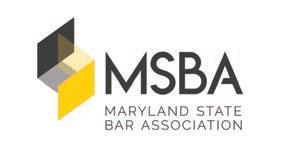











Zoning and the “Sorting Hat” Page 4 Harvesting the Sun on Maryland Farmland Page 18 Peculiar Problems with Variance Ordinances Page 24 LAND USE Volume LI • Number 5 November/December 2018





















18


Published bimonthly by the Maryland State Bar Association, Inc.
520 W. Fayette St. Baltimore, Maryland 21201
Telephone: (410) 685-7878 (800) 492-1964
Website: www.msba.org
Executive Director: Victor L. Velazquez
Editor: W. Patrick Tandy
Assistant to the Editor: Lisa Muscara
Advertising Sales: MCI | USA


Subscriptions: MSBA members receive THE MARYLAND BAR JOURNAL as $20 of their dues payment goes to publication. Others, $42 per year.
POSTMASTER: Send address change to THE MARYLAND BAR JOURNAL
520 W. Fayette St. Baltimore, MD 21201
The Maryland Bar Journal welcomes articles on topics of interest to Maryland attorneys. All manuscripts must be original work, submitted for approval by the Special Committee on Editorial Advisory, and must conform to the Journal style guidelines, which are available from the MSBA headquarters. The Special Committee reserves the right to reject any manuscript submitted for publication.
Advertising: Advertising rates will be furnished upon request. All advertising is subject to approval by the Editorial Advisory Board.
Editorial Advisory Board
Hon. Vicki Ballou-Watts, Chair
Richard Adams
Robert Anbinder
Alexa Bertinelli
Cameron Brown
Susan Francis
Peter Heinlein
Hon. Marcella Holland
Louise Lock
Victoria Pepper
Corinne Pouliquen
Sahmra Stevenson
Gwendolyn Tate
MSBA Officers (2018-2019)
President: Hon. Keith R. Truffer
President-Elect: Dana O. Williams
Secretary: Deborah L. Potter
Treasurer: Hon. Mark F. Scurti
Statements or opinions expressed herein are those of the authors and do not necessarily reflect those of the Maryland State Bar Association, its officers, Board of Governors, the Editorial Board or staff. Publishing an advertisement does not imply endorsement of any product or service offered.
29
24
Land Use Features
4 Zoning and the “Sorting Hat”: Why We Curse Special Exceptions
By Peter Z. Goldsmith and Megan M. Roberts-Satinsky
10 A Possible Avenue to Reach Judicial Review of a “Garden Variety” Administrative Decision Through Alleging Common Law Taxpayer Standing
By Timothy Dugan
14 Takings in Time: Legal Challenges to Land UseMoratoria
Under the Fifth Amendment and Fair Housing Act
 By Thomas G. Coale
By Thomas G. Coale
18 Harvesting the Sun on Maryland Farmland: Local Zoning Restrictions for Solar Fields
 By Casey L. Cirner
By Casey L. Cirner
24 Peculiar Problems with Variance Ordinances
By Derek M. Van De Walle
29 “Quiet Revolution”: Maryland Slowly Takes Back Local Government Land Use Controls
 By Joseph A. Stevens
By Joseph A. Stevens
Departments
34 Committee on Ethics
Ethics Docket No. 2018-06
An attorney’s obligations under the Maryland Rules of Professional Conduct to avoid conflicts of interest between current and former clients in light of the European Union’s General Data Protection Regulation (GDPR).

November 2018 3 MARYLAND BAR JOURNAL
14
Volume LI • Number 5 November/December 2018
Zoning and the “Sorting Hat” Why We Curse Special Exceptions
By Peter Z. Goldsmith and Megan M. Roberts-Satinsky


“[A] special exception, while not exactly twice removed from what is permissible, as the term implies, is nevertheless a conditional allowance.” Costco Wholesale Corp. v. Montgomery Cnty., No. 2450, Sept. Term, 2015, 2018 WL 1747920, at *1 (Md. Ct. Spec. App. Apr. 11, 2018).
Every so often, a local newspaper will publish a headline along the lines of: DEVELOPER AWARDED SPECIAL ZONING EXCEPTION TO DEVELOP COMMERCIAL PROPERTY IN RESIDENTIAL DISTRICT. The headline reflects the misunderstanding that a special exception is an exception to a zoning code or, perhaps, tantamount to a rezoning. See John J. Delaney et al., Handling the Land Use Case 19 (3d ed. 2012) (“The decision to grant or deny a special exception, unlike the decision in a zoning case, does not involve a change in the basic law underlying the parcel of land in question. The zoning applicable to the parcel as indicated on the zoning map remains the same.”). Nonetheless, a failure to understand special exceptions in the world of land use and zoning is understandable. Local jurisdictions have inconsistent statutory criteria for approving special exceptions. The Maryland Code provides a definition of special exception that may be internally contradictory. Finally, the interaction of common law standards with statutory criteria has created a hodgepodge of special exception approval standards throughout Maryland.
Because most readers of the Maryland Bar Journal are presumably unfamiliar with land use law, it is necessary to establish some basic land use, zoning, and planning principles. Generally, land use authority is delegated to a local jurisdiction (county or municipality) that, in enacting a comprehensive zoning ordinance, “divides an area geographically into particular use districts, specifying certain uses for each district.” People’s Counsel for Baltimore County
v. Loyola College, 406 Md. 54, 70 (2008). In so doing, the local jurisdiction typically establishes single-use districts such as residential, commercial or industrial zones, named Euclidean zones after the seminal case of Village of Euclid, Ohio v. Ambler Realty, Co., 272 U.S. 365 (1926). The local government may also establish mixed-use zones which permit a combination of uses such as various intensities of commercial and residential uses. Additionally, local jurisdictions may establish “floating zones,” which are a more flexible zoning “device” than Euclidean zoning. Mayor & Council of Rockville v. Rylyns Enterprises, Inc., 372 Md. 514, 539 n.15 (2002). Within each of these zoning districts, the local jurisdiction will determine what uses are “permitted” and which are “prohibited.” “A permitted use in a given zone is permitted as of right within the zone, without regard to any potential or actual adverse effect that the use will have on neighboring properties.” Loyola, 406 Md. at 71. A prohibited use, on the other hand, is not allowed in the zone. For example, a permitted use in a low-density residential zone would be a single-family dwelling, but a prohibited use in that zone would be a cement manufacturing plant.
“The special exception,” the Court of Appeals has explained, “adds flexibility to a comprehensive legislative zoning scheme by serving as a ‘middle ground’ between permitted uses and prohibited uses in a particular zone.” Id. Where a permitted use is allowed “as of right” and a prohibited use is never allowed, a “special exception, by contrast, is merely deemed prima facie compatible in a given zone” and “requires a case-by-case evaluation by an administrative zoning body or officer according to legislatively-defined standards.” Id. An example of this “middle ground,” which has appeared in more than one reported appellate decision, is a special exception to allow a funeral
November 2018 4 MARYLAND BAR JOURNAL
home in a residential district. Schultz v. Pritts, 291 Md. 1 (1981); Clarksville Residents Against Mortuary Defense Fund, Inc. v. Donaldson Properties, 453 Md. 516 (2017); Anderson v. Sawyer, 23 Md. App. 612 (1974).

Special exceptions require an additional level of scrutiny and typically require a hearing. John J. Delaney et al., Handling the Land Use Case 19 (3d ed. 2012) (“Qualifying for a special exception usually requires a public hearing before an administrative board, such as a board of appeals, board of zoning adjustment or a hearing examiner.”). Logic dictates that this added layer of review is necessary because, presumably, uses requiring a special exception such as landfills, sand and gravel operations, gas stations, and auto and truck recycling facilities, will potentially have adverse effects such as noise, traffic, congestion, environmental concerns, smells, etc. See e.g., Anne Arundel Cnty. Code § 18-6-103.

Uses that require special exception approval are not a homogeneous group and their purported adverse impacts may not be easily identifiable. Local governments also designate special exception uses with less obvious or arguably non-existent inherent adverse effects. Funeral homes, for example, may cause “vague and generalized fear,” such as worries about the structure being an eyesore or attracting bugs, but may, in fact, have minimal tangible impacts like a


slight increase in traffic. See Anderson, 23 Md. App. at 623–24. Solar energy generating facilities are special exception uses in certain zoning districts, but beyond any viewshed impacts, they generate no noise, traffic, dust or odor. See Anne Arundel Cnty. Code 18-6-103.
On the other end of the spectrum from uses like rubble landfills (with obvious inherent adverse effects), are uses that are designated as special exception uses even though they arguably have the same impact as permitted uses in the zoning district. For example, residential uses such as workforce housing, housing for the elderly of moderate means, or duplex dwelling units would have similar adverse impacts to other permitted residential uses but are, nevertheless, treated as special exception uses in certain residential zoning districts in Anne Arundel County. Anne Arundel Cnty. Code § 18-4-106. Further demonstrating the lack of uniformity is that jurisdictions do not treat the same use similarly (e.g., a fast-food restaurant is a permitted use in Anne Arundel County but it is a special exception use in the City of Annapolis). Compare Anne Arundel Cnty. Code § 18-5-101 with City of Annapolis Code § 21.48.030.

The inconsistent nomenclature used by Maryland counties and municipalities tends to increase confusion. While the Court of Appeals has said that the “terms ‘special exception,’ ‘conditional use,’ and ‘special use permit’ are





November 2018 5 MARYLAND BAR JOURNAL 1925 Old Valley Road • Suite 2 • Stevenson, MD 21153 P.O. Box 219 • 410.625.1100 • FX410.625.2174 The Law Offices of Julie Ellen Landau
30 years’
provide a broad depth of knowledge in all family law matters. In our centrally located office in Greenspring Valley,
you with efficiency and a real “get it done” attitude.
ALL FAMILY LAW MATTERS LITIGATION APPEALS MEDIATION NEUTRAL CASE EVALUATION COLLABORATIVE LAW
With over
experience we
we advocate for
We solve problems.
understood to be interchangeable,” Montgomery Cnty. v. Butler, 417 Md. 271, 275 n.1 (2010), that is not true in all jurisdictions. In particular, in Anne Arundel County, a conditional use is a permitted use with conditions, but does not require a hearing. Compare Anne Arundel Cnty. Code 1810-101 et seq. with Anne Arundel County Code § 18-11-101 et seq. In some counties, the term conditional use is synonymous with the term special exception. See Howard County Zoning Regulations § 131.0 et seq.
At the state level, the Land Use Article of the Maryland Code provides a definition of “special exception” that applies to most jurisdictions in the state (but not those governed by the Regional District Act), and defines that term as “a grant of a specific use that: (1) would not be appropriate generally or without restriction; and (2) shall be based on a finding that: (i) the requirements of zoning law governing the special exception on the subject property are satisfied; and (ii) the use on the subject property is consistent with the plan and is compatible with the existing neighborhood.” Md. Code (2012, 2017 Supp.), Land Use, 1-101(p). This definition—which is arguably internally inconsistent, as it is a use that may “not be appropriate generally” and yet must also be consistent with the local jurisdiction’s general development plan—does not incorporate any standards established by the common law.
The modern landmark decision guiding special exception approvals is Schultz v. Pritts, 291 Md. 1 (1981). In Schultz, the Court of Appeals said that special exception uses are presumptively compatible with the permitted uses in that district. Id. at 21. The conclusion in Schultz, which is regularly quoted in case law, is that “there are facts and circumstances that show that the particular use proposed at the particular location proposed would have any adverse effects above and beyond those inherently associated with such a special exception use irrespective of its location within the zone.” Id. at 22. Admittedly, the principles of this test can be difficult to distill, even for the seasoned land use practitioner. To the public, the words can be meaningless.
The practical challenge of applying the Schultz test was evident in People’s Counsel for Baltimore County v. Loyola College, 406 Md. 54 (2008), where a college proposed to develop a spiritual retreat center (a special exception use), in a residential zone. Id. at 58. The Baltimore County Board of Appeals granted the college’s special exception application over citizen opposition. Id. at 59. On appeal, the question was whether Schultz required the Board to compare the potential adverse effects of the proposed use at the subject property to the potential adverse effects at other, similarly zoned properties (i.e., whether a spiritual retreat center might have less impact somewhere else). Id. at 66. The opponents argued that “Schultz compels a district-wide comparative geographic analysis of effects in each special exception.” Id at 94. The college, on the other hand, countered that special exception case law did not require a “multiple site analysis” and only an evaluation of the impacts at the proposed development site, alone, is required. Id. at 105–
07. The Court of Appeals concluded that no “comparative, multiple site impact analysis” was required. Additionally, the Court reaffirmed the presumption of compatibility of special exception uses:
inherent effects [of a special exception use] notwithstanding, the legislative determination necessarily is that the uses conceptually are compatible in the particular zone with otherwise permitted uses and with surrounding zones and uses already in place, provided that, at a given location, adduced evidence does not convince the body to whom the power to grant or deny individual application is given that actual incompatibility would occur.
Id. at 106.
An issue arises when Schultz is considered in conjunction with local requirements that must be proven at a special exception hearing. Typically, a local jurisdiction adopts findings that a zoning body must make before a special exception is granted. For example, Anne Arundel County requires the following findings be made, and these findings explicitly include the Schultz test:
a. Requirements. A special exception use may be granted only if the Administrative Hearing Officer makes each of the following affirmative findings:
1. The use will not be detrimental to the public health, safety, or welfare;
2. The location, nature, and height of each building, wall, and fence, the nature and extent of landscaping on the site, and the location, size, nature, and intensity of each phase of the use and its access roads will be compatible with the appropriate and orderly development of the district in which it is located;
November 2018 6 MARYLAND BAR JOURNAL
“There are facts and circumstances that show that the particular use proposed at the particular location proposed would have any adverse effects above and beyond those inherently associated with such a special exception use irrespective of its location within the zone.”
In addition to the numerous esteemed awards, accolades, and inductions from the legal community, Debbie Potter is this year’s proud recipient of the Maryland Association for Justice’s “Trial Lawyer of the Year” award. As a recipient of this prestigious award, she has been identified as a leader who has made the greatest contribution to the public interest by trying or settling cases that further the goal of keeping Maryland families safe by defending civil rights, consumer rights, workers’ rights, and human rights.
At Potter Burnett Law, our pride of personal injury lawyers has the legal experience, leadership, and proven track record to represent you and your family. Our award-winning lawyers are focused on fighting for the damages you deserve, while protecting your pride and justice in every case. Acclaimed personal injury attorneys Deborah L. Potter, Suzanne V. Burnett, and Andrew T. Burnett understand the importance of standing by your side. Our compassionate and experienced team will confidently represent you, defend your loss, and litigate on behalf of your interests.


Welcoming cases in the areas of car crashes, nursing home abuse, and medical malpractice.













November 2018 7 MARYLAND BAR JOURNAL CALL FOR A FREE CONSULTATION 301.850.7000 16701 Melford Blvd • Suite 421 • Bowie, MD 20715 PotterBurnettLaw.com Let our pride, protect yours. *Each case is different and the law firm’s past record in obtaining favorable awards, judgments, or settlements in prior cases is no assurance of success in any future case. pride AWARD-WINNING It Takes a Lion to be a Leader
January 2018 Jury Verdict $1,100,000 CHARLES COUNTY CIRCUIT COURT * February 2018 Jury Verdict $993,000 DISTRICT OF COLUMBIA SUPERIOR COURT March 2017 Jury Verdict $1,050,000 BALTIMORE CITY CIRCUIT COURT * April 2017 Jury Verdict $1,122,286 HARFORD COUNTY CIRCUIT COURT * * Car Accidents • Nursing Home Negligence • Medical Malpractice
3. Operations related to the use will be no more objectionable with regard to noise, fumes, vibration, or light to nearby properties than operations in other uses allowed under this article;
4. The use at the location proposed will not have any adverse effects above and beyond those inherently associated with the use irrespective of its location within the zoning district;
5. The proposed use will not conflict with an existing or programmed public facility, public service, school, or road;
6. The proposed use has the written recommendations and comments of the Health Department and the Office of Planning and Zoning;
7. The proposed use is consistent with the County General Development Plan;
8. The applicant has presented sufficient evidence of public need for the use;
9. The applicant has presented sufficient evidence that the use will meet and be able to maintain adherence to the criteria for the specific use;
10. The application will conform to the critical area criteria for sites located in the critical area; and
11. The administrative site plan demonstrates the applicant’s ability to comply with the requirements of the Landscape Manual.
Anne Arundel Cnty. Code 18-16-304 (emphasis added).
Montgomery County has modified the Schultz test. The Montgomery County Zoning Ordinance explicitly requires its hearing examiner to consider both inherent effects (e.g., noise associated with deliveries at a senior living facility) and non-inherent effects (e.g., noise from a late-night dance club at a senior living facility in a residential neighborhood):
g. will not cause undue harm to the neighborhood as a result of a non-inherent adverse effect alone or the combination of an inherent and a non-inherent adverse effect in any of the following categories:
i. the use, peaceful enjoyment, economic value or development potential of abutting and confronting properties or the general neighborhood;
ii. traffic, noise, odors, dust, illumination, or a lack of parking; or
iii. the health, safety, or welfare of neighboring residents, visitors, or employees.
Montgomery Cnty. Zoning Ordinance, Article 59-7.3.1(E) (1)(g) (emphasis added).
In Montgomery County v. Butler, 417 Md. 271 (2010), the Court of Appeals approved Montgomery County’s legislative departure from the Schultz presumption of compatibility. The Court of Appeals said: “In reviewing a decision of a zoning board approving or denying an application for a special exception, the emphasis must be first and fore-
most on identifying the relevant and prevailing zoning ordinance. Only then, after determining whether the zoning ordinance is silent on the matters to which Schultz and its progeny speak, may the Schultz line of cases become pertinent and controlling.” Butler, 417 Md. at 306.
In Allegany County, no special exception criteria whatsoever have been adopted and the common law tests and the land use article presumably control.
Without action by the state to establish more uniform special exception standards, practitioners must be aware of differences that exist among each county and municipality, which may include conflicting statutory and common law standards. Practitioners must determine whether their respective jurisdictions have adopted, rejected or are silent with respect to the Schultz test. Finally, the adverse effects of special exception uses, if any, must be analyzed based on the specific and actual area of the proposed development site, as opposed to hypothetical alternatives or a geographical comparative analysis.
Because zoning is predominantly a function of local government, it is unlikely that there will be more uniform standards governing special exceptions in the future. Judge Harrell, now recently retired from the Court of Appeals, captured in an apt analogy why uses end up requiring special exception approval and why there is no guarantee as to how land uses in Maryland’s jurisdictions will be classified: The local legislature, when it determines to adopt or amend the text of a zoning ordinance with regard to designating various uses as allowed only by special exception in various zones, considers in a generic sense that certain adverse effects, at least in type, potentially associated with (inherent to, if you will) these uses are likely to occur wherever in the particular zone they may be located. In that sense, the local legislature puts on its “Sorting Hat” and separates permitted uses, special exceptions, and all other uses. That is why the uses are designated special exception uses, not permitted uses.
Loyola, 406 Md. at 106; see also id. at 106 n. 33 (“In the Harry Potter series of books, the “Sorting Hat” is a magical artifact that is used to determine in which house (Gryffindor, Hufflepuff, Ravenclaw or Slytherin) first-year students at Hogwarts School of Wizardry and Witchcraft are to be assigned. After being placed on a student’s head, the Sorting Hat measures the inherent qualities of the student and assigns him or her to the appropriate house.”).
Mr. Goldsmith and Ms. Roberts-Satinsky are associates in the Annapolis office of Linowes and Blocher LLP. Mr. Goldsmith’s practice focuses on land use in Prince George’s County and Anne Arundel County and real property-related litigation. Ms. Roberts-Satinsky’s practice focuses on land use in Anne Arundel County and environmental law throughout Maryland.
November 2018 8 MARYLAND BAR JOURNAL
1-HOUR DEEP-DIVE AUDIO CLE








in niche federal law topics














LEARN MORE: msba.org/CLEaudio
A Possible Avenue to Reach Judicial Review of a “Garden Variety” Administrative Decision Through Alleging Common Law
Taxpayer Standing
By Timothy Dugan
Recent Maryland Court of Appeals decisions suggest that a person may achieve judicial review from an adverse “garden variety” administrative proceeding by properly alleging “common law taxpayer standing” instead of “property owner standing,” also referred to as “proximity standing.” See Anne Arundel County v. Bell, 442 Md. 539, 113 A. 3d 639 (2015) (“Bell”); and State Center, LLC v. Lexington Charles Limited Partnership, 438 Md. 451, 92 A. 3d 400 (2014) (“State Center”). See also, Greater Towson Council of Community Associations v. DMS Development, LLC, 234 Md.App. 388, 172 A.3d 939 (Md.App. 2017) (“Towson”). Preliminarily, the Courts use the term “taxpayer standing.” I am using the words “common law taxpayer standing” to highlight the common law source of the right, rather than by statute, and to distinguish it from access to the courts through allegations that are grounded on a person’s proximity to the property in question. Also, the term “garden variety” administrative proceeding is intended to refer to, for example, a special exception application proceeding before a board of appeals for a non single family use in a residentially zoned area, such as certain senior housing or a dental office.
The tests for establishing common law taxpayer standing do not appear so burdensome not only for “garden variety” administrative proceedings but also for appeals of legislative actions, like master plans and comprehensive rezonings. For this reason, the dissenting judges’ concern in Bell that a party seeking judicial review, under common law taxpayer standing, will have a difficult time reaching the courts may be misplaced. Bell, 442 Md. at ___, 113 A.
3d at 672.
Before discussing common law taxpayer standing, a short summary of the Court’s elements for alleging property owner/proximity standing may be helpful. A party who participated in the administrative proceeding and whose land is adjoining or confronting the property whose entitlements are under dispute meets the prima facie test for standing. For a property owner who participated in the administrative proceeding and whose property is located further away, “almost prima facie” cases, as described in detail in Ray v. Mayor & City Council of Baltimore, 430 Md. 74, ___, 59 A.3d 545, 555 (2013) (“Ray”), (and as referenced in State Center, 438 Md. at ___, 92 A. 3d at 449), the Ray Court noted:
Although there is no bright-line rule for who qualifies as ‘‘almost’’ prima facie aggrieved, we have found no cases, in which a person living over 2000 feet away, has been considered specially aggrieved. Rather, as we discussed above, this category has been found applicable only with respect to protestants who lived 200 to 1000 feet away from the subject property.
In addition, such almost prima facie property owners must establish some additional harm that distinguished their harm from those of the general public, known as a “plus factor.” Ray, 430 Md. at ___, 59 A.3d at 551. Examples of plus factors are: harm from a change in the character of the neighborhood, harm from increased traffic, and harm from the project interrupting sight or views. Ray, 430 Md. at ___, 59 A.3d at 556. A litigant must actually own the land being affected; thus, a
community association that owns no land may not be the entity that is the “anchor” for the appeal. See Towson. A local law or regulation may establish reasonable limits on statutorily established property owner standing. See Sugarloaf Citizens Association v. Department of Environment, 344 Md. 271, ___, 686 A. 2d 605, 613 (1996), and as cited in Chesapeake Bay Foundation v. DCW Dutchship Island, 439 Md. 588, ___, 97 A. 3d 135, 141 (2013). Property owner/ proximity standing allegations do not provide access to the courts when opposing a comprehensive rezoning. See Bell. A thorough discussion of property owner/proximity standing may be found in the recent Towson decision by the Court of Special Appeals decision as well as Bell and StateCenter
There are, however, limitations with respect to property owner/proximity standing that a party might be able to overcome by successfully alleging the necessary elements of common law taxpayer standing. For instance, in State Center, the Court explains that a taxpayer, who is able to make the allegations properly, has access to the courts arising from a common law right, not one arising from a statute. The common law taxpayer standing doctrine permits taxpayers to seek the aid of courts, exercising equity powers, to enjoin illegal and ultra vires acts of public officials where those acts are reasonably likely to result in pecuniary loss to the taxpayer. [Citing, 120 West Fayette Street, LLLP v. Mayor of Baltimore, 407 Md. 253, 267, 964 A.2d 662, 669–70 (2009)]
[C]ourts often require that the com-
November 2018 10 MARYLAND BAR JOURNAL
. . .
plainant not have an adequate remedy at law. [citations omitted.] Where the complainant does not have an adequate remedy at law, however, the common law demands that we permit the suit unless the General Assembly has preempted this common law right.
State Center, 438 Md. at ___, 92 A. 3d at 451, and at 454.
The Court further explains common law taxpayer standing as follows: In other words, [common law taxpayer standing], when asserted properly, provide[s] both the cause of action (or claim) and the right of the individual to assert the claim in the judicial forum. Moreover, [common law taxpayer standing] provide[s] [an] avenue[] for a complainant to challenge what may be termed as a ‘public wrong.’
State Center, 438 Md. at ___, 92 A. 3d at 439.
The Court in State Center outlines the allegation elements for common law taxpayer standing. State Center, 438 Md. at ___, 92 A. 3d at 451, et seq. which are paraphrased below.
The complainant must be a taxpayer (and not a pass through entity). The person must pay the type of taxes that are the subject matter of the grounds for the taxpayer’s standing.
By inference, but not explicitly set forth in the case law regarding common law standing, the taxpayer must remain in the case throughout the appeal. See Towson, a proximity standing case. In Towson, the appeal was dismissed for lack of standing, because of the withdrawal of the only party who held the right to judicial appeal, a property owner.
It appears that “piggyback standing” would be allowed, where one or more persons would be allowed to participate in the appeal, even though they do not have independent judicial standing themselves, as long as those who hold common law taxpayer standing remain. An example of the Court’s determination is found in Sugarloaf Citizens Association v. Department of Environment, 344 Md. 271, ___, 686 A. 2d 605, 618 (1996).
Where there exists a party having standing to bring an action, we shall not ordinarily inquire as to whether another party on the same side has standing.
The taxpayer must allege sufficiently that the case is proceeding on behalf of the taxpayer and on behalf of all other taxpayers similarly situated. The allegation will be deemed adequate if it is stated explicitly or implicitly (by necessary implication). State Center, 438 Md. at ___, 92 A. 3d at 457-461. The prudent appellant would allege explicitly that the appeal is being brought on behalf of the taxpayer and all taxpayers similarly situated.
The next element explained in State Center is the allegation that the governmental action is a primary action and that such action is illegal or ultra vires. State Center, 438 Md. at ___, 92 A. 3d at 462. In Bell, the Court cites several cases where taxpayer standing was upheld to challenge administrative determinations in the courts. See Bell, 442 Md. at _____, 113 A. 3d at 663 664. The cited cases do not involve a “garden variety” administrative appeal, such as an appeal of a board of appeals decision; however, the nature of an alleged illegal act or alleged ultra vires action should not be limited to just those fact patterns. In the case of an administrative appeal, the taxpayer would allege that a board of appeals, for example, misinterpreted the zoning provision and, thus, illegally applied the requirement, or that the board of appeals exceeded its authority, because the ruling was not within the bounds of the board’s authority. The standing determination might have been different in the case, Committee for Responsible Development on 25th Street v. Mayor and City Council of Baltimore, 137 Md. App. 60, 767 A.2d. 906 (2001), if common law standing allegations were plead correctly. A person unsuccessfully argued standing as a taxpayer only under the now MD Code, Land Use Section 10 501 “Procedure, Baltimore City” standing for judicial review, which is based on “property owner standing” or “proximity standing.” The appellant did not allege appellate standing under
common law standing.
The common law taxpayer standing allegations must include that the illegality or ultra vires action caused or will cause the taxpayer a “pecuniary loss or an increase in taxes.” In Bell, the Court instructed that if individual taxpayers (in that case, opposing the comprehensive rezoning action) had alleged in its original pleadings, not later, that it would suffer a pecuniary loss or an increase in taxes, the persons might have achieved taxpayer standing. In footnote 30, the Court references a memorandum where there were allegations of property value decrease [arguably a pecuniary loss], tax assessment increases [an express element of taxpayer standing], increases in traffic, and alteration of neighborhood character. The Court notes:
As these statements were not made in support of allegations contained in the Complaint for Declaratory Judgment nor the Amended Petition for Judicial Review, they are not available to make out a prima facie showing of the ‘‘harm’’ required by taxpayer standing.
Bell, 442 MD. at ____, 113 A. 3d at 667.
The types of harm alleged as arising from illegal or ultra vires acts that the Court has been asked to consider include: harm from invalid statutes, harm from decreases in governmental efficiency, harm from costs to fend off illegality, and harm from the waste of public funds. State Center, 438 Md. 451, ___, 92 A. 3d at 466-467.
The Court also requires that the person allege (that is, not establish before the appeal is underway) that it is reasonable to conclude that a nexus exists between the alleged illegal or ultra vires actions and the person’s allegation that such acts will cause pecuniary loss or an increase in taxes. State Center, 438 Md. 451, ___, 92 A. 3d at 472. For the individual taxpayer, the amount of the alleged loss or increase need not be significant. State Center, 438 Md. 451, ___, 92 A. 3d at 477.
It seems that a person who opposes a garden variety administrative decision could allege common law taxpayer standing as follows, using some hypo-
November 2018 11 MARYLAND BAR JOURNAL
thetical facts for illustration purposes:
1. The person is claiming standing through common law taxpayer standing.
2. Whether the taxpayer person did or did not participate in the administrative proceeding might be irrelevant.

3. The person is a taxpayer. In this hypothetical, assume that the taxpayer pays real property taxes and individual state and local county or city income taxes.
4. The person is bringing the appeal on its own behalf and on behalf of the other taxpayers similarly situated, in the role of a private attorney general. In this example, the “attorney general” would allege that it is be looking out for the taxpayers who live not only as adjoining and confronting property owners/ taxpayers but also for those who live further away in the general neighborhood or even further away and perhaps pass by the subject property every day or very infrequently, if at all. The “attorney general” would allege that the class’s property values will depreciate and their taxes will increase because of the additional burden from the proposed to-be-redeveloped property. The fundamental argument is that the common law taxpayers would not be limited to those who could satisfy “property owner standing/aka proximity standing.”

5. Assuming that the taxpayers remain and anchor the appeal, non-taxpaying entities like community associations could also participate even though they are not taxpayers. (Sugarloaf)
6. Allege that the board of appeals (in this example), an administrative body and a government official, illegally and ultra vires ruled that:
a. The zoning statute allows height to be measured from “X” location versus “Y” location.
b. The zoning statute allows setback to be measured from “X” location versus “Y” location.
c. The project would be compatible with the neighborhood generally.
d. The project would not unduly burden the roads.

e. The project would not unduly impact the environment.


f. The architecture is compatible with the neighborhood.
g. The applicant must install off site landscaping and the government must assume maintenance responsibility.
7. The taxpayer would allege that if the project were allowed to be developed, the common law taxpayers would suffer pecuniary losses. Their homes would be less valuable because of the presence of the project and its activities in the neighborhood. The taxpayers would pay more real property taxes and individual in-
come taxes. The taxes would be reasonably expected to increase to construct and maintain new infrastructure that will not be paid for entirely by the applicant, including, off site roadways, off site sidewalks, schools, and off site stormwater management facilities.
8. The remedy of not allowing the project to be approved, based on the alleged illegal and ultra vires actions of the government officials, will be that the opposition will not suffer pecuniary losses and will not pay more taxes arising from the project.
For the above reasons, it seems that securing judicial review might be easier using adequately pled common law taxpayer standing allegations than allegations under “property owner/proximity standing.”
Mr. Dugan is Co-Chair of the Zoning and Land Use Practice Group at Shulman Rogers in Potomac, Maryland.

November 2018 12 MARYLAND BAR JOURNAL
410-296-4408 www.firstmdtrust.org

















November 2018 13 MARYLAND BAR JOURNAL
Takings in Time:
Legal Challenges to Land Use Moratoria Under the Fifth Amendment and Fair Housing Act
By Thomas G. Coale
As public infrastructure has lagged behind residential development and public polling shows more support for anti-development policies, jurisdictions across Maryland have implemented de juris or de facto development moratoria that have significantly constrained the use of private property. Federal courts have recognized such blanket controls as legitimate planning tools that may be used to stop development while new regulations are being considered. Nevertheless, property owners often turn to their counsel to identify what remedies they may have, if any, to remove this restraint or receive compensation.
Frustrated land owners may be disappointed to hear that both federal and Maryland state courts have viewed land use moratoria favorably in the context of the Fifth Amendment. Understanding the temporal value of property, a present constraint may be allowed so long as there is a promise of future value. Nevertheless, there are still instances in which poorly considered land use moratoria may be overturned or result in the payment
of just compensation. Similarly, land use moratoria may also be vulnerable to challenge under the federal Fair Housing Act when they operate to exclude certain housing products, such as multi-family homes.

Land Use Regulation and the Takings Clause
The Fifth Amendment provides: “No person shall . . . be deprived of
November 2018 14 MARYLAND BAR JOURNAL
Property owners often turn to their counsel to identify what remedies they may have, if any, to remove this restraint or receive compensation.
life, liberty, or property, without due process of law; nor shall private property be taken for public use, without just compensation.” Although local jurisdictions are afforded significant deference by federal courts in the application of land use regulations, the courts have recognized that there is a point past which the police power manifests as a “regulatory taking”.
In contrast to those circumstances in which the government physically takes possession of an interest in property, a “regulatory taking” occurs when a property is stripped of all economic value due to the constraints of land use regulation. While manifestly different in terms of the possessory interest, the Supreme Court has held that both categories of taking require compensation under the Fifth Amendment. First English Evangelical Lutheran Church v. County of Los Angeles, 482 U.S. 304, 318, 107 S.Ct. 2378, 2387, 96 L.Ed.2d 250 (1987) (“[T]emporary’ takings which ... deny a landowner all use of his property, are not different in kind from permanent takings, for which the Constitution clearly requires payment.”).
There ar two types of regulatory takings. The first is a per se taking which deprives the landowner of all economic use of its property. This is most commonly referred to as a Lucas taking or a “per se” total taking. Lucas v. South Carolina Coastal Council, 505 U.S. 1003, 1018, 112 S.Ct. 2886, 2894-95, 120 L.Ed.2d 798 (1992). In Lucas, a property owner filed for just compensation after a local regulation prevented him from building on two coastal lots. Due to the fact that there could be no other economical use of the land, the Court found that his claim for a taking under the Fifth Amendment could proceed.
If the taking is not per se, and the property still retains some, albeit diminished, economically beneficial uses of its land, then the Court will evaluate the fairness of the regulation under a multi-factor test set forth in Penn Central Transportation Co. v. City of New York wherein courts are to weigh the necessity of the governmental regulation against the private interests
of the land owner. 438 U.S. 104, 98 S. Ct. 2646, 57 L. Ed. 2d 631 (1978). These factors include “the economic impact of the regulation on the claimant and, particularly, the extent to which the regulation has interfered with distinct investment backed expectations,” as well as the “character of the governmental action.” Id. at 124, 107 S.Ct. at 2660. This test is designed to recognize that every government regulation affects property value in some sense and that assessing compensation for every such diminishment of value would grind government to a halt.
Temporary Regulatory Takings
Up until 1987, the Supreme Court had not ruled on whether temporary regulation could manifest as a regulatory taking. In First English Evangelical Lutheran Church v. County of Los Angeles, the Court found in the affirmative, holding that property owners had the right to be compensated for temporary regulatory takings. 482 U.S. 304, 107 S.Ct. 2378, 96 L.Ed.2d 250 (1987). In that case, the plaintiff, a religious facility, owned land in a California creek basin, which it operated as a retreat and campground. After a flood destroyed the church’s buildings in the basin, Los Angeles County adopted an “interim ordinance” that precluded structures from being rebuilt therein. The church filed suit, claiming, in part, that the ordinance “denies [appellants] all use” of the property, and sought damages for the taking.
After claims for just compensation had been struck in state court, the United States Supreme Court reversed. The Court held that the Fifth Amendment
applied to permanent and temporary regulatory takings alike and that property owners subject to such regulations may recover damages for inverse condemnation. The Court held that “[i]t is axiomatic that the Fifth Amendment’s just compensation provision is ‘designed to bar Government from forcing some people alone to bear public burdens which, in all fairness and justice, should be borne by the public as a whole.’” Id. at 318, 107 S.Ct. at 2388 (citations omitted). As emphasized by later court decisions, First English did not hold that the property owner was entitled to such damages or that a taking had occurred. Rather, this holding was limited to the proposition that a claim for inverse condemnation may be brought in response to a temporary regulatory taking.
The Supreme Court refined the First English holding in Tahoe-Sierra Preservation Council v. Tahoe Regional Planning Agency, which held that a temporary thirty-two month land-use moratorium did not constitute a per se “total taking” of the property. 535 U.S. 302, 122 S. Ct. 1465, 152 L.Ed.2d 517 (2002). The Court found that when evaluating the elimination of a property’s value, the property should be viewed in both a physical and temporal capacity (i.e., the property’s value over time). Id. at 331-32, 122 S. Ct. at 1483-84. In this context, a temporary moratorium cannot constitute a per se taking, as the property will recover its value as soon as the prohibition is lifted. The Court further reasoned that the interest in facilitating informed decision-making by regulatory agencies counsels against adopting a rule that would impose such severe costs on their deliberations and that “[m]oratoria are an essential tool of successful development.” Id. at 304, 122 S. Ct. at 1469.
After rejecting the application of Lucas, the Court applied the Penn Central multi-factor test and held that the duration of the moratorium was reasonable to allow the governmental agency time to develop a regional planning document. Nevertheless, in dicta the Court noted that mortatoria lasting
November 2018 15 MARYLAND BAR JOURNAL
Courts are to weigh the necessity of the governmental regulation against the private interests of the land owner.
longer than one year require “special skepticism”. Tahoe-Sierra, 535 U.S. at 304, 122 S.Ct. at 1470.








Despite the language of skepticism, the Supreme Court has not set a “bright line” rule on how long is “too long” for temporary regulatory takings. Rather, the reasonableness of the duration of the moratorium is evaluated on a case-by-case basis in relation to the purpose for the freeze in development and the economic impact on the property owner. Rolling moratoria, or a moratorium with no set end date, would not be found reasonable when held against the investment-backed expectations of land owners. See City of Monterey v. Del Monte Dunes at Monterey, Ltd., 526 U.S. 687, 119 S.Ct. 1624, 143 L.Ed.2d 882 (1999) (Court upheld the award of regulatory takings damages based on a pretextual refusal to accept one development plan after another, when each plan complied with the city’s previous demands).















Maryland Case Law












The most relevant case for evaluating temporary takings under Maryland law is Maryland-National Capital Park and Planning Commission v. Chadwick. 286 Md. 1, 405 A.2d 241 (1979). In that case, the Court of Appeals held that a park commission resolution placing property in reservation for up to three years, without any reasonable uses permitted as of right, was tantamount to a “taking” in the constitutional sense and, because the resolution did not provide for payment of just compensation, the resolution was unconstitutional. The court applied the multi-factor test under Penn Central, finding that the “resolution does not merely circumscribe a beneficial use of the property; it inhibits all beneficial use for up to three years, without any guarantee that the property will be acquired in the future.” Id. at 16, 405 A.2d. at 248.
There are two other opinions from the Court of Special Appeals that bear relevance here. In Steel v. Cape Corp., the Court of Special Appeals held that an adequate public facilities ordinance that prohibited the zoning authority
November 2018 16 MARYLAND BAR JOURNAL September 2018 16 MARYLAND BAR JOURNAL ...when the estate administration turns to litigation. 5300 Dorsey Hall Drive, Suite 107 Ellicott City, Maryland 21042 Phone: 410-696-2405 Fax: 877-732-9639 kinghall-law.com
counsel you can trust...
Refer to
from rezoning a parcel to residential uses unless the applicant could establish adequate school capacity was an unconstitutional regulatory taking.
111 Md. App. 1, 677 A.2d 634 (1996). In that case, the plaintiff bringing suit had attempted to have his parcel rezoned from undeveloped open space to residential. There was an acknowledged mistake in the original zoning, as the open space zone was only to be applied to parcels owned by community associations. The court concluded that this was a per se taking under Lucas, holding that “[w]hile a situation where such adequacy of facility statutes slow growth might be constitutionally permissible, it is not constitutionally permissible where the type of growth reduction occurs at the expense of a property owner’s loss of viable economic use of his property.”
Id. at 23, 677 A.2d at 645.
The Steel case only applies to per se takings and not the multi-factor weighing of interests set forth in Penn Central. The Steel court observed that to the extent the ordinance had only precluded an increase in residential density there would remain a viable economic use if there was an existing residential use of the property. Id at 36, 677 A.2d at 651 (“We perceive that, if the present zoning of a subject property is other than [Open Space] and permits some viable residential or reasonable commercial use, the statutory scheme as applied to those types of properties may withstand ‘takings’ scrutiny.”).
The Maryland Court of Special Appeals specifically addressed the constitutionality of temporary takings under a development moratorium in S.E.W. Friel v. Triangle Oil Company. 76 Md. App. 96, 543 A.2d 863 (1988). In that case, the court upheld a nine-month development moratorium in Queen Anne’s County. Due to the fact that the appellant had not sought just compensation, the court did not take the occasion to apply the holding of First English as it relates to temporary regulatory takings, but rather limited its scope to whether such moratoria were constitutional. Finding that it was, the
court held that the “Fifth Amendment does not prohibit the taking of private property; it merely makes compensation a condition of the exercise of that power.” Id. at 104, 543 A.2d. at 867.
Maryland appellate courts have not had the opportunity to evaluate temporary moratoria since the Supreme Court’s 2002 Tahoe-Sierra decision. As such, there have been no cases evaluating the reasonableness of temporary moratoria or applying the Penn Central test to determine whether there has been a compensable taking related to the implementation of moratoria.
Fair Housing
Understanding the narrow grounds upon which a temporary land development moratorium may be found to require just compensation under the Fifth Amendment, it is worth considering a lesser known avenue for challenging restrictive zoning practices under the federal Fair Housing Act.
On November 10, 2016, the Department of Justice (“DOJ”) and the Department of Housing and Urban Development (“HUD”) issued a joint statement updating guidance about how the federal Fair Housing Act applies to state and local land use and zoning laws. The memorandum identified five categories of regulatory action that may violate the Fair Housing Act, one of which is relevant here:
• Prohibiting or restricting the development of housing based on the belief that the residents will be members of a particular protected class, such as race, disability, or familial status, by, for example, placing a moratorium on the development of multifamily housing because of concerns that the residents will include members of a particular protected class.
Joint Statement of the Department of Housing and Urban Development and the Department of Justice, State and Local Land Use Laws and Practices and the Application of the Fair Housing Act (Nov. 10, 2016), https:// www.justice.gov/opa/file/912366/ download.
Land use or zoning practices that result in an unjustified discriminatory effect or disparate impact on a particular group of persons, or otherwise perpetuates segregated housing patterns, may be found to violate the Federal Housing Act and give rise to a cause of action under federal law. It is notable that the two federal departments explicitly identified land use moratoria as a potential violation of the Fair Housing Act. While it is unlikely that a blanket application of a development moratorium would satisfy the more specific requirements that would constitute a violation of the Act, particularized prohibitions, such as a moratorium on multifamily or apartment dwellings, would likely be vulnerable to challenge in federal court.
Conclusion
State and local governments have significant discretion in constraining property rights for the sake of public planning and ensuring adequate public facilities. Nevertheless, these powers have limits. When land use regulations arbitrarily rob property owners of their development rights for a prolonged or uncertain period of time, federal courts will find that a regulatory taking has occurred. The absence of case law defining those limits is more likely the consequence of local jurisdictions self-reversal than the imposition of the courts.
In light of the political pressures that bring land use moratoria into existence, attorneys should consider whether the restraints on development have a disparate effect on protected communities or otherwise perpetuate the segregated housing established by decades of mortgage redlining. If so, a case that may originally have been filed as inverse condemnation may be better suited as a challenge to the legality of the law under the Fair Housing Act.
Mr. Coale is an attorney with the law firm of Talkin & Oh, LLP, in Ellicott City, Maryland, where he regularly represents property owners in zoning matters and real estate litigation. He may be reached at tcoale@talkin-oh.com.
November 2018 17 MARYLAND BAR JOURNAL
HARVESTING THE SUN ON MARYLAND FARMLAND
LOCAL ZONING RESTRICTIONS FOR SOLAR FIELDS
 By Casey L. Cirner
By Casey L. Cirner

The ideal location for a utility scale solar generation facility (solar farm) is a large swath of flat, cleared land (i.e., farmland). The availability of agricultural land, either through purchase or lease, coupled with Maryland’s renewable energy goals and the community solar pilot project (discussed below), has many Maryland counties seeing an influx of zoning and regulatory applications for solar farms on agricultural land. These same counties are concerned that the solar projects will diminish the available agricultural land and are tightening zoning regulations to further restrict its use. But, the effectiveness of these local efforts remains to be seen because, typically, State law impliedly preempts local law in the area of solar farms. This could leave many local regulations without teeth.
On February 2, 2017, the Maryland General Assembly, through gubernatorial veto override, passed legislation to increase Maryland’s renewable energy goals to 25 percent in 2020. Acts 2017, c. 1, § 5, eff. Oct. 1, 2016. Subsequently, Maryland implemented a “community solar” pilot project, which will make solar energy available to all in-
quality of life issue for certain rural areas and residents. Press Release, Anne Arundel County, Anne Arundel County Announces Eight Month Industrial Solar Operations Ban (Dec. 3, 2017). The eight-month moratorium ended on August 30, 2018, with the Anne Arundel County Council’s introduction of Bill 89-18. Bill 89-18 imposes stricter zoning regulations on solar fields per the recommendations of the County’s Agriculture, Agritourism, and Farming Commission.
Caroline County lifted its six-month moratorium on solar fields on December 12, 2017, through enactment of Ordinance #2017-2. Before that, Frederick County enacted a six-month moratorium by Executive Order No. 01-2016, effective January 15, 2016. On May 16, 2017, Frederick County adopted a solar facility commercial floating zone district (the “Floating Zone”) for the use of agricultural land for solar fields that requires a corresponding land use designation in the Comprehensive Plan. Frederick County Code § 1-19-10.700. After the expiration of Frederick County’s moratorium, the Baltimore County Council enacted its
agricultural land are not allowed by right, but rather pursuant to either a special exception (conditional use) or other zoning application, such as the Floating Zone. Anne Arundel County Bill No. 89-18; Caroline County § 175-13; Baltimore County Code § 4E-102(A); Wicomico County Code § 255-155B(2); Dorchester County Code § 155-50(LL); Cecil County Code § 54.4; Frederick County Code § 1-1910.700. The resulting zoning standards in these counties restrict solar fields on agricultural land in various ways by including, for instance, provisions for:
• A limit on the amount of prime agricultural soils that can be disturbed for solar projects. Anne Arundel County Bill No. 89-18; Frederick County Code § 1-1910.700(C)(4).
• A cap on the total acreage available for solar farms in the county. Caroline County Code § 175-85(A)(1). (Caroline County recently reduced the 3,000 acres of the County that can be used for solar farms to 2,000 acres. Id.)
• A cap on the number of facilities within each council district. Baltimore County Code § 4E-102(B) (4). (Only 10 solar farms, at any one time, are permitted in each council district. Id.)
come levels through a subscription to a single solar farm. COMAR 20.62.01, et seq. As a result, solar farms (utility scale and community) continue to be developed in rapid succession.
Many counties have imposed moratoriums on construction of solar farms in order to strengthen their zoning restrictions to strike a balance between what some perceive as competing public interests. Anne Arundel County most recently enacted a moratorium to halt the use of agricultural land for solar fields, framing the problem as a
own moratorium via Bill No. 68-16, which was vetoed by the late County Executive Kevin Kamenetz. Notwithstanding, the Baltimore County Council adopted amendments to its solar farm zoning regulations. Currently, Somerset County is in the process of amending its solar ordinance.
An underlying theme of the resulting zoning amendments adopted or proposed by the above counties and the zoning provisions already in place within some of the remaining Maryland counties is that solar fields on
• A cap on lot coverage or net area of the site used for the solar field. Anne Arundel County Bill No. 89-18; Frederick County Code § 1-19-10.700(C)(5).
• Prevention of the development within environmental features, such as environmentally sensitive areas, animal habitats, planned greenways and require forest conservation law compliance or other limitations on tree removal. Anne Arundel County Bill No. 89-18; Caroline County Code §§ 175-85(A)(4) and (B) (2); Baltimore County Code § 4E-104(A)(10); Frederick County
November 2018 20 MARYLAND BAR JOURNAL
The increased use of agricultural land for utility scale solar generation facilities (solar fields that generate power for sale) has many Maryland counties struggling with how to balance two public interests – renewable energy and farmland.
Many counties have imposed moratoriums on construction of solar farms in order to strengthen their zoning restrictions to strike a balance between what some perceive as competing public interests.
Code § 1-19-10.700(C)(7).
• Imposition of buffer and screening requirements, including fencing. Anne Arundel County Bill No. 89-18; Baltimore County Code §§ 4E-104(A)(6) and (7); Dorchester County Code § 15550(LL)(1)(e) and (k).
• Protection of viewsheds, agricultural, conservation and historic preservation easements. Anne Arundel County Bill No. 89-18; Caroline County Code § 175-85(A)(3), §§ 175-85(B)(1) and (4); Baltimore County Code §§ 4E-104(A)(1)-(5); Frederick County Code § 1-19-10.700(B)(4); Dorchester County Code § 15550(LL)(1)(g).
• Regulation of glare and visible light. Anne Arundel County Bill No. 89-18; Caroline County Code §§ 175-85(B)(6) and (7); Baltimore County Code § 4E-104(A)(8); Dorchester County Code §§ 15550(LL)(1)(a) and (d).
• Imposition of a decommissioning plan, with a decommissioning bond/security, or other solar panel and infrastructure removal requirements. Anne Arundel County Bill No. 89-18; Caroline County Code § 175-85(C); Baltimore County Code § 4E-107; Frederick County Code § 1-1910.700(C)(10); Dorchester County Code § 155-50(LL)(1)(l).
• Imposition minimum distances between commercial solar projects. Anne Arundel County Bill No. 89-18.
Some counties prefer not to strike a balance, but to prohibit solar farms altogether on agricultural land. For example, Montgomery County has 90,000 acres of land in its agricultural reserve and allows solar only as an accessory use on that land (i.e., free-standing solar array must produce a maximum of 120 percent of the on-site consumption). Montgomery County Code § 59.3.7.2.B.1.
Despite these local efforts, the Maryland Public Service Commission (PSC) has jurisdiction to approve solar fields through the certificate of public conve-
nience and necessity (CPCN) process. Public Utility Article (PUA) § 7-207(b) (1)(i). It is recognized in certain instances that the CPCN process preempts the local zoning processes. The seminal case, Howard County v. PEPCO., 319 Md. 511 (1990), held that State law impliedly preempted local law in the field of public utility service. Specifically, the Court of Appeals held that State law preempted the Montgomery County Zoning Ordinance special exception requirements governing the location of power lines in excess of 69,000 volts because the State granted the PSC broad powers in this field and the State law gave no controlling deference or approval rights to the local jurisdiction. The State law merely provided for the PSC to give “due consideration to the recommendations of such bodies.” Id. at 526.
The “due consideration” standard is still applicable today. PUA § 7-207(e) (1) provides for “due consideration” of “the recommendation of the governing body of each county or municipal corporation in which any portion of the construction of the generating station…is proposed to be located.”
However, in 2017, H.D. 1350, 2017 Leg., 437th Sess. (Md. 2017) and S. 851, 2017 Leg., 437th Sess. (Md. 2017) added two additional criteria to which the PSC must give “due consideration”:
(1) the consistency of the application with the comprehensive plan and zoning or each county or municipal corporation where any portion of the generating station is proposed to be located” and; (2) “the efforts to resolve any issues presented by a county or municipal corporation where any portion of the generating station is proposed to be located.” PUA § 7-207(e)
(3). This triggered some counties to question whether preemption of local zoning was still the case.
The PSC’s public utility law judge (“PULJ”) relied on the State’s implied preemption of local regulations in the field of solar generation facilities when it initially approved the LeGore Bridge Solar Center, LLC’s application for a 20 megawatt solar field on agricultural land in Frederick County.
Proposed Order, P.S.C. Case No. 9429, 44-46 (Oct. 3, 2017). LeGore obtained special exception approval from Frederick County for its solar field prior to consideration of its CPCN application and Frederick County’s replacement of the solar farm special exception process with the piecemeal Floating Zone process. Id. At the close of the CPCN record, Frederick County filed with the PULJ a copy of the Floating Zone legislation to advance the notion that LeGore’s special exception was no longer valid and that it had to obtain Floating Zone approval. Id. at 33. The PULJ held in its Proposed Order that State law preempted Frederick County’s local zoning restrictions and alternatively, LeGore had obtained a special exception, and the special exception approval included a finding of conformance with the Comprehensive Plan. Id. at 46.
Frederick County appealed the Proposed Order to the PSC on multiple grounds. Notice of Appeal, P.S.C. Case No. 9429, 44-46 (Nov. 1, 2017). It argued against preemption on the basis of the recently enacted § 7-207(e) (3), Pub. Util., Md. Ann. Code, which added due consideration be given to the local jurisdictions’ Comprehensive Plan and zoning, thereby creating “complementary roles in the process” for the County and State. Frederick County, Maryland’s Memorandum of Appeal, P.S.C. Case No. 9429, 9 (Nov. 9, 2017). Frederick County also argued that the holding in HowardCounty was limited to public service companies, which LeGore was not. Id.
Without addressing preemption, the PSC upheld the Proposed Order on alternative grounds. In re: LeGore Bridge Solar Center, LLC, 2018 WL 1586448 (Md.P.S.C). It concluded that LeGore had vested its special exception and due process prevented the PSC from requiring LeGore to undergo the floating zone process so late in the game. Id. The PSC’s dissenting opinion argued that “due consideration” equates to “considerable weight” and by overlooking Frederick County’s comprehensive plan recommendations and Floating Zone, the PSC was deviating
November 2018 21 MARYLAND BAR JOURNAL
from its normal practice. Id. The dissenting opinion also rebuffed LeGore’s reliance on preemption when it specifically mentions LeGore’s strategy to continue with the special exception process when faced with a moratorium and Frederick County’s proposed Floating Zone legislation. Id
Although the PSC declined to approve LeGore’s CPCN on the basis of preemption, the Court of Special Appeals recently addressed preemption in an unreported opinion. On August 28, 2018, the Court of Special Appeals issued unreported opinion, Board of County Commn. of Washington County v. Perennial Solar, LLC, 2018 WL 4090873, that upheld the issuance of a CPCN for a solar farm on the basis that local zoning regulations are preempted by State law and the applicant, although not a public utility company, was governed by the PSC because it was a “person” under PUA § 7-207(b)(1)(i) over which the PSC has jurisdiction to issue a CPCN. However, the CPCN at issue was subject to PUA § 7-207(e) before the amendments enacted by H.D. 1350, 2017 Leg., 437th Sess. (Md. 2017) and S. 851, 2017 Leg., 437th Sess. (Md. 2017). Accordingly, the viability of preemption by State law of local zoning requirements and Comprehensive Plan recommendations appears to be uncertain at this time, absent a subsequent decision by a PULJ, PSC, or Maryland appellate court.
Thus, preemption by State law may continue to be challenged by the local jurisdictions. However, the counties will likely continue to establish more stringent solar field zoning regulations and adopt Comprehensive Plans touching on solar field locations, in an attempt to preserve farmland – all balanced against the CPCN process.
Ms. Cirner is an associate in the Rockville offices of Miles & Stockbridge P.C.
Disclaimer: This article is for general information and is not intended to be and should not be taken as legal advice for any particular matter. It is not intended to and does not create any attorney-client relationship. The opinions expressed and any legal positions asserted in the article are those of the author and do not necessarily reflect the opinions or positions of Miles & Stockbridge, its other lawyers, or the Maryland State Bar Association.
LEGAL CAPITAL, 4thEd
Legal Capital is widely credited with pioneering the introduction of the balance sheet and equity solvency tests, as well as other reforms in the Model Business Corporation Act and corporation statutes in over 30 states. This edition adds new historical material, updates the statutes and caselaw on dividends and other distributions in the U.S., and compares the evolution of legal capital in countries around the world.

“Legal Capital turns on a basic tension around the corporate form — how the concept of limited liability can place creditors’ and shareholders’ interests at odds, and how that tension isresolved through statute, case law, and private contracting. It is a must-read for corporate law students, academics, and practitioners, and a must-have for law firm and university libraries.”
Charles K. Whitehead Myron C. Taylor Alumni Professor of Business Law Cornell Law School
November 2018 22 MARYLAND BAR JOURNAL
Visit | store.westacademic.com Call | 800-782-1272 email | inquiries@westacademic.com © 2018 LEG, Inc. d/b/a West Academic Publishing 101409 lb/6.18 West, West Academic Publishing, and West Academic are trademarks of West Publishing Corporation, used under license.
9781599417721
Bayless Manning, Late Former Dean, Stanford Law School James J. Hanks, Jr., Partner, Venable LLP, Baltimore
MARYLAND CHAPTER
The following attorneys are recognized for Excellence in the field of Alternative Dispute Resolution
The following attorneys are recognized for Excellence in the field of Alternative Dispute Resolution











Check preferred available dates or schedule appointments online directly with Maryland’s top neutrals
www.MDMediators.org is funded by these members

Check preferred available dates or schedule appointments online directly with Maryland’s top neutrals www.MDMediators.org is funded by these members
 Sean Rogers Leonardtown
Hon. Steven Platt Annapolis
Richard Sothoron Upper Marlboro
Snowden Stanley Baltimore James Wilson Rockville
Hon. Monty Ahalt Annapolis
Jonathan Marks Bethesda
Daniel Dozier Bethesda
Douglas Bregman Bethesda
Hon. Carol Smith Timonium Scott Sonntag Columbia
Sean Rogers Leonardtown
Hon. Steven Platt Annapolis
Richard Sothoron Upper Marlboro
Snowden Stanley Baltimore James Wilson Rockville
Hon. Monty Ahalt Annapolis
Jonathan Marks Bethesda
Daniel Dozier Bethesda
Douglas Bregman Bethesda
Hon. Carol Smith Timonium Scott Sonntag Columbia
NADN is a proud sponsor of the national trial
bar associations... To visit our free National Directory of litigator-rated neutrals, please visit www.NADN.org
John Greer Simpsonville
and defense
Peculiar Problems with Variance Ordinances
By Derek M. Van De Walle
In this article, I am not talking about variances in critical areas, nor do I discuss use variances in any in-depth respect.
When reviewing a grant or denial of a variance, the court will “look first to the words of the applicable statute, ordinance, or regulation to divine what the enabler intended the weight to be accorded by the ultimate decision-maker to a recommendation of the plan.” Richmarr Holly Hills, Inc. v. American PCS, L.P., 177 Md. App. 607, 636 (1997). Due to the manner in which local ordinances and regulations are worded, this process requires the occasional divination by the court. Although generally applicable criteria and standards exist for reviewing variance applications, these criteria and standards are often rendered inapplicable due to the wording of the ordinance itself. Exacerbating this problem is that no two variance ordinances in Maryland are alike, with the language varying among each of the twenty-four counties. The differences range from how a variance is defined to the standards applied when granting or denying a variance application. While local zoning authorities and land use practitioners may be familiar with the nuanced differences in variance ordinances, often, the average applicant is not. Two continuing sources of confusion for members of the public in variance construction are discussed below: the meaning of the “unique” requirement and the use of conjunctives or disjunctives for the practical difficulties and unnecessary-hardship tests. This article highlights this confusion and discusses how, in recent years, Maryland courts have attempt-
ed to thwart the problems they create.
The Difference (or Lack Thereof) Between “Peculiar” and “Unique”
One of the many criteria that are required for a variance application to be granted is that the property in question must be “unique.” A property is considered “unique” when it has inherent characteristic not shared by other properties in the area, i.e., its shape, topography, subsurface condition, environmental factors, historical significance, access or non-access to navigable waters, practical restrictions imposed by abutting properties (such as obstructions) or other similar restrictions. Cromwell v. Ward, 102 Md. App. 691, 710 (1995).
The Land Use Article, however, does not use the term “unique.” Instead, “peculiar” is used in its place: “and where, owing to conditions peculiar to the property and not because of any action taken by the applicant, a literal enforcement of the zoning law would result in unnecessary hardship or practical difficulty, as specified in the zoning law.” LU § 1-101(s) (emphasis added).
Many Maryland counties – for example, Calvert, Carroll, Cecil, Dorchester, Frederick, Saint Mary’s, and Wicomico – follow suit and use “peculiar” in their ordinances to define “variance.”
Other counties – such as Caroline, Montgomery, and Queen Anne’s –include “peculiar” when discussing the standards for variances. Somerset and Garrett Counties do both, and Allegany and Washington Counties do
neither. Calvert and Prince George’s Counties use “peculiar” and “unusual” when describing “practical difficulties” and “unnecessary hardships” in their standards. Charles County does this as well, but also requires that any special conditions on the property be “unique” to the property. Worcester County uses “special or unique” to describe how the conditions of the property must be. Talbot County uses solely “unique” in its standards. Baltimore City and Kent Counties set the threshold even higher by requiring that the special conditions be “extraordinary.”
Generally, “peculiar” means something that is strange or unusual, while “unique” means something that is “one of a kind.” But in the context of variance cases, they are synonymous with one another. However, this has not always been clear. Cromwell v. Ward, 102 Md. App. 691 (1995), could be read to imply that “peculiar” and “unique” are separate standards. This is most likely due to the fact that the appellant presented it as such. Basing his argument on the Baltimore County Zoning Ordinance, the appellant argued that the restrictions of the applicable ordinance “taken in conjunction with the unique circumstances affecting the property,” must be the cause of the hardship (emphasis the court’s), and that the variance could only be granted where special circumstances or conditions exist that are peculiar to the land or structure which is the subject of the variance request . . . .” Id. at 694 (emphasis the court’s). The Cromwell court held that the law in Maryland “has always been a property’s peculiar characteristic or unusual circumstances relating only and uniquely to that
November 2018 24 MARYLAND BAR JOURNAL
property must exist in conjunction with the ordinance’s more severe impact on the specific property because of the property’s uniqueness . . . .” Id. at 721 (emphasis added). The use of the disjunctive “or” would seem to imply that there is a difference between “peculiar” and “unusual” as they are used to modify “characteristic” and “circumstances,” respectively; at other times, the court appeared to use the terms interchangeably. Regardless, the distinction between “peculiar” and “unique” was not at issue in the Cromwell case, and so the court would have seen no reason to address it.
In 2017, the Court of Special Appeals sought to correct this problem by erasing any distinctions among “peculiar,” “unique,” and “unusual” in Dan’s Mountain Wind Force, LLC v. Allegany County Board of Zoning Appeals, 236 Md. App. 483 (2018). Allegany County, a home-rule county, does not provide any standards for reviewing variance applications. Instead, variances are mentioned only in the “definitions” section. The Allegany County Code, at section 360-59(A)(1), defines a zoning variance as a:
change of density, bulk[,] or area requirements, with respect to the loca-
tion of a building or a use on a lot of record, where the physical or natural character of the lot would otherwise preclude the use of the lot.
As noted above, this definition includes neither the word “peculiar,” seen in most definitions of “variance” in Maryland counties, nor the word “unique.” With no standards in the ordinance to rely on, the court implemented the general two-part standard “to determine whether a variance should be granted in a particular case.” Dan’s Mountain, 236 Md. App. at 491. The first part is the “uniqueness” test. Id. at 492. In applying the test, the court acknowledged that “Maryland cases have used the terms ‘unique,’ ‘unusual,’ and ‘peculiar’ to describe this step in the variance analysis.” The court asserted that “[w]e made clear in Cromwell that these words are used more or less interchangeably to mean ‘unusual.’” Id. at 494 (citing Cromwell, 102 Md. App. at 703). Whether the Cromwell case in fact does this is debatable, but Dan’s Mountain effectively ends that debate with its decisive language. And by doing so, Dan’s Mountain makes it clear that the differing use of “unusual,” “unique,” or “peculiar,” throughout the 24 county or-
dinances means nothing because they are one and the same concept.
Using Conjunctive and Disjunctive Terms for the Practical Difficulties and Unnecessary Hardship Standards
Variances fall into two categories: area variances, providing variances from area, height, density, and setback restrictions; and use variances, permitting a use other than that permitted in the particular district by the ordinance. See Dan’s Mountain, 236 Md. App. at 501. Maryland permits only area variances. See LU § 1-101(s) (“‘Variance’ means a modification only of density, bulk, dimensional, or area requirements in the zoning law that is not contrary to the public interest . . . .”) (emphasis added).
Area and use variances, theoretically, require different standards. The less stringent “practical difficulty” test applies to area variances, while use variances, because they could potentially change the nature of the neighborhood, face the “unnecessary hardship” or “unwarranted hardship”

November 2018 25 MARYLAND BAR JOURNAL
standard. Dan’s Mountain, 236 Md. App. at 501. In practice, however, the tests can be applied to both area and use variances due to local ordinance wording. This problem is best summarized by a footnote in the Cromwell case: Some ordinances use the conjunctive, “and,” creating a requirement that both practical difficulty “and” unreasonable hardship exist. Because hardship is the most severe standard, this means that it is the standard used regardless of whether an area or use variance is sought. Some ordinances use the disjunctive, “or,” to separate the two standards. These jurisdictions construe the ordinance to require the unreasonable hardship standard to be used when “use” variances are sought, because use variances are believed to be more disruptive of zoning goals and purposes, but require the lesser “practical difficulty” standard when “area” variances are sought. Cromwell, 102 Md. App. at 695 n.1. Thus, when an ordinance uses the conjunctive “and” in between “practical difficulties” and “unnecessary hardships” in the context of area variances, the applicant is required to meet both standards. This was the case in North v. St. Mary’s County, 99 Md. App. 502 (1994). There, the Circuit Court for St. Mary’s County affirmed a decision by the county board of appeals to grant an area variance. In reversing that decision, the Court of Special Appeals observed that though it may be argued that this is an area variance and that under most zoning codes the applicant’s burden would be limited to showing practical difficulty, the statute at issue here is mandatory and requires not an either/or showing but the satisfying of all the requirements, i.e., the showing of an “unwarranted hardship” and special features of the site . . . . North, 99 Md. App. at 512-13. The same situation occurred in an even earlier case. In Anderson v. Board of Appeals, Town of Chesapeake Beach, the Court of Special Appeals, reviewing the grant of a variance in the Town
of Chesapeake Beach, indicated that the Town zoning ordinance permitted area variances only. 22 Md. App. 28, 41 (1974). Despite this fact, because the ordinance also “expressed the criteria of practical difficulty and unnecessary hardship in the conjunctive,” both standards had to be met in order for the variance to be granted. Id.
These cases highlight what can happen when the conjunctive “and” is used. This poses a problem for applicants because the unnecessary hardship test increases the burden on the applicant to meet the higher standard. In Chesapeake Beach, the court noted that the ordinance defines “hardship” as “the equivalent of a constitutional taking, and utilizes the same criteria employed by the Court of Appeals for establishing undue hardship.” Id. The threshold to demonstrate that a taking has occurred is high: in order to find that a constitutional taking has occurred, a regulation must deny “all economically beneficial use or productive use of land . . ..” Palazzolo v. Rhode Island, 533 U.S. 606, 617 (2001).
Given the difficulty applicants face meeting a constitutional taking standard, the Court of Appeals has clarified that the taking standard does not apply to variances. In Assateague Coastal Trust, Inc. v. Schwalbach, the Court held that the “‘unwarranted hardship’ standard is not as demanding as the ‘taking’ standard.” 448 Md. 112, 128 (2016). Looking to the language in the Natural Resources Article at section 8-1808(d) (1), the Court noted that “unwarranted hardship” means that “an applicant would be denied reasonable and significant use of the entire parcel or lot for which the variance is requested.”
The Schwalbach case drew a line between a taking standard and the unwarranted hardship standard, but it
did so only in the context of critical area variances. Several county ordinances distinguish between general area variances and those variances sought for property in critical zones (e.g., Somerset, Talbot, and Wicomico Counties), while Garrett County maintains zoning regulations only in the Deep Creek Watershed and several surrounding towns and cities. Yet, many counties do not provide any distinction between general zoning districts and critical areas; these counties also tend to refer to the practical difficulties and unwarranted-hardship standards in the conjunctive. If the Schwalbach case does not apply to those county ordinances referring to the two standards in the conjunctive, then variance applicants would rarely meet the taking standard for an area variance. But even if the Schwalbach holding applies, applicants are still left to contend with the unwarranted hardship standard for area variances, when they should, theoretically, only be required to demonstrate practical difficulties.
Although the language of LU § 1-101(s) refers to the two standards in the disjunctive -- “a literal enforcement of the zoning law would result in unnecessary hardship or practical difficulty as specified in the zoning law” -- county ordinances do not always reflect this. While differentiation among county ordinances may be beneficial, and even necessary, for local communities, the lack of uniform criteria and standards creates problems for members of the general public. It is evident that in recent years, Maryland courts have cured any issues created by ordinance wording, but it is important to remember that although general criteria and standards may exist in the context of variances, these are often rendered impracticable due to the language of local zoning ordinances.
Mr. Van De Walle is a law clerk for the Maryland Court of Special Appeals.
Disclaimer: This article is the opinion of the author, and does not necessarily reflect the opinion of the Maryland Court of Special Appeals or any member of the Maryland Judiciary.
November 2018 26 MARYLAND BAR JOURNAL
The unnecessary hardship test increases the burden on the applicant to meet the higher standard.

“Quiet Revolution
Maryland Slowly Takes Back Local Government Land Use Controls
By Joseph A. Stevens
It has been almost 50 years since the publication of “The Quiet Revolution in Land Use Control” made a strong case that state government, not local governments, are best suited to implement sound land use policy. Fred Bosselman & David L. Callies, Council on Envtl. Quality, The Quiet Revolution in Land Use Control (1971). The authors observed: Innovations wrought by the “quiet revolution” are not, by and large, the results of battles between local governments and states from which the states eventually emerged victorious. Rather … in the growing awareness on the part of both local communities and statewide interests that states, not local governments, are the only existing political entities capable of devising innovative techniques and governmental structures to solve problems such as pollution, destruction of fragile natural resources, the shortage of decent housing, and many other problems that are not widely recognized as simply beyond the capacity of local governments . . . . Id at 3. The authority to regulate land use comes from the state, and legislatures have delegated varying degrees of land use controls to local governments. See, Md. Code Ann., Loc. Gov. §§ 5-213, 10-324; Md. Code Ann., Land Use. States such as Hawaii, Oregon, New Jersey and Vermont have long established land use control at the state level. Booming population, spikes in development applications and building permit activity, combined with small, fragmented township/municipal government made it nearly impossible for some states to implement regional planning strategies that transcended local boundaries.
For example, Vermont, a rural state, faced significant growth pressure decades ago that threatened agriculture. Its municipal form of local government, which changes every few miles, is not only ineffi cient in many respects, but is also a system destined to fail at implementing meaningful regional land use policy without signifi cant
state involvement. Many states, such as Hawaii, have adopted unifi ed state land use controls, complete with a state plan and land use restrictions.

Maryland’s Experience
Until relatively recently, in Maryland the authority to plan, zone and otherwise control land use had been firmly at the local level, leaving all major policy-making up to the counties and municipalities. Maryland’s strong form of county government had long forestalled efforts for more regionalized planning because such controls, to a certain extent, were in fact already “regionalized” due to large areas of land falling within a single county. The relatively few municipalities in Maryland are, for the most part, urban/ town centers or rural villages, and the vast majority of the State’s land is under the jurisdiction of the counties. Maryland counties have strong political roots and are highly influential over the State legislature, making it difficult to pass any sweeping land use reforms. Furthermore, county government planning agencies very often have the tools and possess the skills crucial to implementing sound planning policies and regulations, thereby making State oversight less necessary.
Either by design or default, however, over the past four decades Maryland has strung together a series of laws which when looked at as a whole, protects the State’s interests in it natural resources, and establishes a comprehensive planning policy that crosses county and municipal boundaries. These legislative actions have taken the form of laws aimed at environment protection and agricultural preservation, local comprehensive planning, and restricting State funding for new infrastructure projects to approved growth areas only.
November 2018 28 MARYLAND BAR JOURNAL
”
Environmental Protection
Maryland has passed much legislation to protect specific environmental features such as tidal wetland, Md. Code Ann., Envir. §16-101, et seq., nontidal wetlands, Md. Code Ann., Envir. §5-901 et seq., and forests Md. Code Ann., Nat. Res. §15-1601, et seq. The passage of the Chesapeake Bay Critical Area laws and regulations materially shifted land use control back to the State, at least in the Critical Area.
The Chesapeake Bay has been, and continues to be the catalyst of politicians, environmentalists, and planners to advocate for more statewide control of land use. The negative effects of land use decisions on Chesapeake Bay water quality have been well documented. Bill Dennison & Michael Williams, University of Maryland Center for Environmental Science, Land Use and the Chesapeake Bay Report Card, (2007). In 1984, the Maryland General Assembly enacted “Chesapeake Bay Critical Area Protection Program,” Md. Code Ann., Nat. Res. §§8-1801 et seq
(later amended to include “Atlantic Coastal Bays,” hereinafter referred to as the “Critical Area Law.”) Within the Critical Area, the State implemented regulations on land use, density, lot coverage, and limitations on future growth in each tidewater jurisdiction. The law established a commission and staff to develop regulations, oversee local government programs and implement the Critical Area Law (“Critical Area Commission”).
For those not familiar with the Critical Area Law, it applies to land within a 1,000 feet of tidal waters or wetlands. The goals of the Critical Area program are:
1. To minimize adverse impacts on water quality that result from pollutants that are discharged from structures or conveyances or that have run off from surrounding lands;
2. To conserve fish, wildlife, and plant habitat; and
3. To establish land use policies for development in the Chesapeake Bay Critical Area . . . . which accommodate growth and also address the fact that, even if pollution is controlled, the number, movement, and activities of persons in that area can create adverse environmental impacts.
Md. Code Ann., Nat. Res. §8-1808(b).
The Critical Area Commission adopted “criteria,” (regulation) which divides all affected lands into one of three categories. COMAR 27.01.02.03(A). Intensely Developed Areas (IDA) are those areas where residential, commercial, institutional, and/or industrial developed land uses predominate, and where relatively little natural habitat occurs. Limited Development Areas (LDA) are those areas which are currently developed in low or moderate intensity uses. They also contain areas of natural plant and animal habitats, and the quality of runoff from these areas has not been substantially altered or impaired. Resource Conservation Areas (RCA) are those areas characterized by nature-dominated environments (that is, wetlands, forests, abandoned fields) and resource-utilization activities (that is, agriculture, forestry, fisheries activities, or aquaculture). In the RCA, new subdivision activity is limited to a density of one dwelling per twenty acres and new commercial or industrial uses are not permitted.
The law placed a cap on the expansion of new IDAs and LDAs through the use of “growth allocation” which is overseen by the Critical Area Commission. The land use policies that evolved from the Critical Area law were particularly impactful on the rural tidewater jurisdiction. You see, counties with highly developed shorelines (IDAs), like Baltimore and Prince George’s, felt little impact on its planning policies while rural jurisdictions (the majority of Critical Area in RCA’s) were forced to rethink where growth could occur so as to comply with the new law and regulations.
The Critical Area Commission has a seat at the table on site plans, subdivisions, special exceptions, variances, and most other land use activity that occurs in the Critical Area. The Commission is party to all proceedings and has on many occasions used its oversight authority to appeal local government decisions. The Critical Area Law and regulations fall only slightly short of being statewide zoning for the land area affected.
Maryland state planners have long expressed their concern with negative effects of rural subdivisions on the State’s agricultural resources. Governor William Donald Schaefer’s administration led a failed legislative effort in the early 1990s to mandate significant subdivision/development limitations in rural areas. Senate Bill 227, S. 227, 1991 Sess. (Md. 1991), and House Bill 214, H.D. 214, 1991 Sess. (Md. 1991). Also see Philip J. Tierney, University of Baltimore Law Review, Bold Promises But Baby Steps: Maryland’s Growth Policy to the Year 2020 (V. 23, Spring 1994). Two decades later, Maryland passed the Sustainable Growth and Agricultural Preservation Act of 2012 (the “Sustainable Growth Act”) Md. Code Ann. Envir. § 9-206; Md. Code Ann. Land Use §1-501 et seq. which in effect achieved what was attempted decades earlier.
The effect of the Sustainable Growth Act is to limit development activity utilizing on-site septic systems in rural and agricultural parts of the State. Thus, in areas planned or zoned by a local jurisdiction for “land, agricultural, re-

November 2018 29 MARYLAND BAR JOURNAL
Abraham Carpio, Esq.
Adam J. Bushey, Esq.
Alan Lescht, Esq.
Alex Brown, Esq.
Alex Fine, Esq.
Amy Tobias, Esq.
Andrew Alpert, Esq.
Andrew Alpert, Esq.
Ann Metayer, Esq.
Ariel Solomon, Esq.
Arya Saleh, Esq.
Bhanu Ilindra, Esq.
Bobby Malek, Esq.
Brian Gruber, Esq.
Carl Lauer, Esq.
Carleton Penn, Esq.
Carolyn Grimes, Esq.
Carolyn Thaler, Esq.
Charles Bagley Iv, Esq.
Charles Keenan, Esq.
Charles Laduca, Esq.
Clifford Hardwick, Esq.
Dana Zelman, Esq.
Daniel Barrera, Esq.
Daniel Leavitt, Esq.
Daniel Miller, Esq.
Darren Crew, Esq.
David Gardner, Esq.
David Harbin, Esq.
David Ruben, Esq.
Dawn Deboer, Esq.
Deborah M. Shelton, Esq.
Deborah R Meshulam, Esq.
E. Curtis Schwab, Esq.
Eric Kirk, Esq.
Fredric Press, Esq.
Geoffrey Goodale, Esq.
Gwen-Marie Davis Hicks, Esq.
Jamaica Szeliga, Esq.
James T. O'Hara, Esq.
Jamie Hamelburg, Esq.

Jay M. Tannon, Esq.
Jeffrey Weaver, Esq.
Jill Michaels, Esq.
Jill Pogach Michaels, Esq.
John Daroff, Esq.
John Kent Kidwell, Esq.
John Zydron, Esq.
Jonathan Beiser, Esq.
Jonathan Emord, Esq.
Jonathan Stroud, Esq.
Joshua A. Levy, Esq.
Junghoon Samuel Kim, Esq.
Katherine Martell, Esq.
Kenneth Chadwick, Esq.
Kerri Cohen, Esq.
Kerry Staton, Esq.
Kerry Verdi, Esq.
Kevin Lacey, Esq.
Kevin T. Hadden, Esq.
Kimberly Knight Wayland, Esq.
Leslie Ann Shaner, Esq.
Lloyd Malech, Esq.
Marvin Liss, Esq.
Michael Myers, Esq.
Michael Nicholas, Esq.
Michael Troy, Esq.
Michele Gallagher, Esq.
Miguel Palmeiro, Esq.
Miguel Palmeiro, Esq.
Mona Tehrani, Esq.
Natalie Thingelstad, Esq.
Nicholas Porritt, Esq.
Pamela Johnson Branch, Esq.
Paul D. Bekman, Esq.
Paul Tolzman, Esq.
Pawnee A. Davis, Esq.
Peter Fayne, Esq.
Pooja Bhagat, Esq.
Richard Toikka, Esq.
Rick Jaklitsch, Esq.
Robert Dellinger, Esq.
Roy Baldwin, Esq.
Schantell Comegys, Esq.
Scott Kazem, Esq.
Sharie Brown, Esq.
Stephanie Rapp-Tully, Esq.


Stephen A. Markey, Iii, Esq.
Stuart Herschfeld, Esq.
Stuart Malawer, Esq.
T. Chappell Aldridge, Esq.
Theodore Vakrinos, Esq.
Thomas Maloney, Esq.
Valerie Edwards, Esq.
William Burgy, Esq.
William F. Renahan, Esq.
William Fawcett, Esq.
William Thrush, Esq
*Lawyers of Distinction uses it own independent criteria, including both objective and subjective factors in determining if an attorney can be recognized as a Lawyer of Distinction in the United States in their respective field. This designation is based upon the proprietary analysis of the Lawyers of Distinction organization alone and is not intended to be endorsed by any of the 50 United States Bar Associations or The District of Columbia Bar Association

November 2018 30 MARYLAND BAR JOURNAL NOW ACCEPTING APPLICATIONS FOR 2018 LAWYERSOFDISTINCTION.COM RECOGNIZING EXCELLENCE IN THE PRACTICE OF LAW Congratulations to Our Newest Maryland, Virginia and Washington D.C. Lawyers
source protection, preservation, conservation; as well as areas dominated by agricultural lands, forest lands, or other natural areas” (known as “Tier IV”), subdivision is capped at not more the seven (7) lots per any existing parcel. Md. Code Ann. Envir. § 9-206(f). For large agricultural tracts containing hundreds or thousands of acres, the impact is substantial.
The Sustainable Growth Act moved through the Legislature with relative ease, and the State had finally achieved what amounts to a statewide low density “agricultural zone” that is consistent throughout each jurisdiction. This was quite an accomplishment for growth management in Maryland, the significance of which is still underrated (and perhaps under-appreciated).
Comprehensive Planning, Consistency and Land Use Controls

In the early 1990s, Maryland slowly began to establish more requirements for local governments to prepare comprehensive plans, and what those plans must include. The Economic Growth, Resource Protection and Planning Act of 1992 (the “1992 Planning Act”) was the result of a summer study committee made up of both State and local government interests, following the Schaefer administration’s stalled efforts to mandate Statewide land use con-
trols. While the 1992 Planning Act did not mandate zoning densities or shift oversight of the local decisions to State agencies, it did set the framework for comprehensive planning requirements. The 1992 Planning Act also set forth a series of eight “Visions” which compromise the State’s development policy. Md. Dep’t. of Planning, Planning Legislation. https://planning.maryland.gov/Pages/OurWork/ Plan-Legislation.aspx (last visited Oct. 17, 2018).
Importantly, the 1992 Planning Act required “streamlined development review” in designated growth areas and consistency between comprehensive plans and implementing land use regulations such as zoning. The 1992 Planning Act was an early step in the State mandate to require land use regulations and zoning designations consistent with comprehensive plans. This mandated consistency is now well imbedded in numerous pieces of legislation and caselaw.
The Land Use-Local Government Planning Act passed in 2006 affects municipal growth areas, annexation and coordination between municipalities and counties, as well as the makeup of municipal comprehensive plans. Md. Code Ann. Land Use, Title 1, Subtitle 1 and 4; Title 3, Subtitle 1-3; Title 4, Subtitle 2; and Title 7, Subtitle 3. The Land Use-Local Government Planning Act updated municipal annexation laws that had been unchanged for many years. The new law requires more detailed planning before a municipality can annex land. This law required all municipal compre-
November 2018 31 MARYLAND BAR JOURNAL
Get a fast quote today! www.mlmins.com or contact Kay G. Kenny 443-955-4829 or kkenny@mlmins.com You can trust over 35 years of experience protecting lawyers. Put your trust in the carrier created by lawyers, run by lawyers, exclusively serving lawyers. Protecting Your Practice is Our Policy.® • Works exclusively with lawyers professional liability insurance • Specializes in solo to mid-size rms • Returned over $56 million in pro ts to policyholders since 1988 • O ers an array of services to mitigate risks Recommended by the Maryland State Bar Association.
hensive plans to include a municipal growth element and a water resources element and prohibited rezoning of newly annexed areas unless municipalities met the new planning requirements. Maryland Department of Planning, Models & Guidelines, Volume 25, Writing the Municipal Growth Element to the Comprehensive Plan May 2007 Publication No. 2007-001.
Not long after the Land Use-Local Government Planning Act, came the “Smart, Green, Growing…Plan Consistency” legislation of 2009 (“Plan Consistency Act”). The Plan Consistency Act was the direct result of Trail v. Terrapin Run, LLC. 401 Md. 523(2008), which held that absent language in the local zoning ordinance requiring strict conformity, the words “conform to” in the former Md. Code Ann. Article 66B, § 1.00(k) (now the Land Use Article) did not require strict compliance between a comprehensive plan and a special exception use. Id. at 526-27, 547. In 2009, the planning community and General Assembly, concerned with the holding in Terrapin Run, amended Article 66B, Section 1.01 to define “consistency” with the comprehensive plan to mean an “action taken to further, and not be contrary to,” the “policies; timing of implementation of the plan; timing of development; timing of rezoning; development patterns; land uses; and, densities or intensities.” This memorialized the consistency mandate between comprehensive plans and implementing land use regulations.
Funding Sewer, Water, and Highways
In the 1989 movie Field of Dreams, voices tell Kevin Costner’s character, Ray Kinsella, “If you build it, they will come,” referring to the construction of a baseball field and the arrival of baseball greats who had passed to play on the field. The phrase has become a cliché in the planning world, often used to impress upon the reader/listener the impact of infrastructure investment on growth patterns. If
Fin. Proc. §5–7B–02 through 04. At the risk of overgeneralizing a comprehensive statute, the effect of the Priority Funding Act is really threefold. First, it defines what may constitute a PFA—that is, existing municipal corporations, existing population centers, as well as those undeveloped areas planned for growth. To establish new PFA’s a local jurisdiction must designate the area for growth, plan for sewer and water service in the area within 10 years, and have a minimum allowable zoning density of 3.5 dwellings per acre. §5–7B–03(e).
Second, before a local jurisdiction can designate an area as a PFA, it must provide (1) an analysis of the capacity of land areas available for development, including in-fill and redevelopment; and (2) an analysis of the land area needed to satisfy demand for development at densities consistent with the local master plan. §5–7B–03(f). If the land capacity analysis does not support a demand to add new land areas to a PFA, the State may reject the designation.
Third, if not designated a PFA, the State cannot (with limited exception) provide funding for growth-related projects, such as extension of sewer lines, transportation improvements and schools. §5–7B–04 (a). Given that most public wastewater treatment facilities have been constructed using at least some State funding, sewer service (again with very limited exceptions) can no longer be provided outside of PFAs.
Conclusion
Since the mid 1980s, the “Quiet Revolution” has come to Maryland but in a form perhaps more acceptable to local governments than an outright affront on local authority through a statewide land use plan and mandated zoning regulations. Local governments maintain much control over most significant land use decisions, but within a complex framework of State laws and oversight by multiple State agencies. The State has regained control over its most sensitive and rural areas (Critical Area law and the Sustainable Growth Act). The State legislated that all jurisdictions prepare comprehensive plans based on the State development policy (8 Visions) and mandated consistency with implementing land use controls, including but not limited to rezonings, special exceptions and zoning ordinances. Wrapping a bow around its land use policies, the State has passed laws that prohibit the use of State funding for new sewer/water/highways etc. in areas outside of PFAs.
government builds the sewer line and the highway, houses and people will follow. Conversely, if the state refuses to fund any infrastructure in rural or non-growth areas, then those areas will see less development pressure.
Maryland memorialized the concept of “if you DON’T build it, they won’t come” in the 1997 Priority Funding Areas Act (“Priority Funding Act”) which restricted the use of State funding for infrastructure to those areas designated by local government (and approved by the State) as Priority Funding Areas (PFAs).
The Priority Funding Act is codified in Md. Code Ann.
When looked at as a whole, the “Quiet Revolution” in Maryland has been very quiet indeed, but not without material impact, advancing the State’s interest in land use policy-making.
Mr. Stevens, of the Law Offices of Stevens Palmer, LLC, has practiced land use law for over 25 years, prior to which he served as the Planning Director for Queen Anne’s County, Maryland. He is a member of the MSBA Land Use Institute Faculty and Planning Committee, and was a member of the State Land Use Code ReWrite Committee.
November 2018 32 MARYLAND BAR JOURNAL
If the state refuses to fund any infrastructure in rural or non-growth areas, then those areas will see less development pressure.
November 2018 33 MARYLAND BAR JOURNAL
MARYLAND STATE BAR ASSOCIATION, INC.
COMMITTEE ON ETHICS
ETHICS DOCKET NO. 2018-06
An attorney’s obligations under the Maryland Rules of Professional Conduct to avoid conflicts of interest between current and former clients in light of the European Union’s General Data Protection Regulation (GDPR).

November 2018 34 MARYLAND BAR JOURNAL
You have asked about your obligations under the Maryland Rules of Professional Conduct (“MRPC”) to avoid conflicts of interest between current and former clients in light of the European Union’s General Data Protection Regulation (“GDPR”), which became effective on May 25, 2018.
You have stated that there are circumstances under which the GDPR may require you to delete information needed to identify a client or former client and the matters upon which you worked, if the client or former client requests that you do so. This is colloquially referred to as the “right to be forgotten.” You are concerned that, if you comply with such a request, you would be unable adequately to check for conflicts for purposes of complying with Rules 19-301.7 or 19-301.9 of the Maryland Rules of Professional Conduct (“MRPC”).
This Committee is empowered only to interpret the MRPC and therefore cannot render an opinion as to your legal obligations under the GDPR. There may be exceptions in the GDPR itself that would permit an attorney to retain sufficient information to adequately check for conflicts of interest, even if a former client requests deletion of its data. If this is the case, this aspect of the GDPR raises no ethical issue.
Ethical issues arise, however, if the GDPR does require an attorney to delete all identifying information pertaining to a client or former client, upon the client’s request. In that case, the requesting client may effectively render it impossible for a firm or an individual attorney to check for conflicts between current and former clients. Assuming that this is the case, we draw two conclusions:
1. Rules 19-301.7 and 19-301.9, which govern attorney conflicts of interest, do not directly impose specific requirements to maintain records. Rather, those rules impose an obligation upon lawyers to avoid the specified conflicts of interest, unless a waiver has been obtained for waivable conflicts. While the GDPR may prevent an attorney from maintaining records, it would not authorize or compel an attorney to engage in a conflicted representation, and thus cannot alleviate an attorney’s obligation to comply with Rules 19-301.7 and 19-301.9.
2. If a former client asks an attorney to delete the information needed to manage conflicts of interest, and the GDPR requires the attorney do so, we believe that the client’s request can act as a waiver of conflicts that could have been discovered had the data been retained if: (1) the firm provides written advice to the former client that fully informs the former client that deleting the information could result in a conflict and that by requiring such deletion the client consents to the firm’s potential future representation of other clients with conflicts that might otherwise have been discovered, and (2) none of the attorneys who handle the matter for the firm have any retained knowledge of the former client’s information.
Background
In general, the GDPR applies to the processing of personal data that is automated or part of a filing system. It applies when (a) the processing of personal data relates to an establishment of a controller or processor in the EU; (b) when the processing relates to data subjects in the EU and relates to the offering of goods and services within the EU and the “monitoring” of behavior of EU subjects within the EU, or (c) where personal data is processed in a place where the law of an EU member state applies under international law. GDPR, Article 3. “Processing” of data includes the storage and retrieval of such data; “personal” data would include names and addresses, and similar identifying information; and a “controller” is an entity that has the ability to control what is done with data within the scope of the GDPR. Article 4. You are concerned that some identifying information pertaining to your current or former clients may fall within the scope of the GDPR, including former EU clients and prospective EU clients who submit information for purposes of engaging legal services, but the engagement never comes to fruition.
Article 17(1) of the GDPR provides that “[t]he data subject shall have the right to obtain from the controller the erasure of personal data concerning him or her without undue delay” where one of several circumstances applies, such as when “the personal data are no longer necessary in relation to the purposes for which they were collected or otherwise processed.” Article 17(3) of the GDPR sets out some circumstances under which such data can be retained despite subsection (1), such as when retention is necessary to comply with an obligation under EU law or the law of an EU member or necessary for the establishment or defense of legal claims. You have asserted that there is a potential that a former or prospective client’s identifying information may fall within the scope of Article 17, and that you may therefore be required to remove all information about that former or prospective client from your records.
Attorneys retain information to identify current and former clients in order to avoid potential conflicts of interest. Rule 19-301.7 applies to conflicts generally and prohibits an attorney from representing a client in a matter where the lawyer’s representation of the client will be affected by the lawyer’s duty to a former client (among others). Rule 19-301.7(a)(2). This Rule defines the lawyer’s duty to a current client. Under Rule 19-301.7, among other things, an attorney cannot represent two clients if the representation of one client is directly adverse to another client, or if there is a significant risk that an attorney’s representation of one client will be materially limited by the representation of the other. The two clients can give written consent to the attorney’s representation, however, so long as (1) the representation does not involve an assertion of a claim on behalf of one client against another client who the attorney also represents in that same proceeding, (2) the attorney reasonably believes that the attorney will be able to provide competent and diligent representation to each affected client,
November 2018 35 MARYLAND BAR JOURNAL
and (3) the representation is not prohibited by law. Rule 19-301.7(b).
Rule 19-301.9 applies directly to conflicts between a current and a former client and defines the lawyer’s duty to the former client. Under Rule 19-301.9(a), “[a]n attorney who has formerly represented a client in a matter shall not thereafter represent another person in the same or a substantially related matter in which that person’s interests are materially adverse to the interests of the former client unless the former client gives informed consent, confirmed in writing.” Under Rule 19-301.9(b), “[a]n attorney shall not knowingly represent a person in the same or a substantially related matter in which a firm with which the attorney formerly was associated had previously represented a client: (1) whose interests are materially adverse to that person; and (2) about whom the attorney had acquired information protected by Rules 19-301.6 (1.6) and 19-301.9(c) (1.9) that is material to the matter; unless the former client gives informed consent, confirmed in writing.”
Discussion
As you note in your letter, there may be exceptions in the GDPR that would permit an attorney or firm to retain information pertaining to a client’s identity and matter, even if the client requests deletion of such information. You identified several arguments in your request for an opinion that may avoid such an event. If an attorney is permitted to retain such information, the attorney should do so in order to ensure compliance with Rules 19-301.7 and 19-301.9.
Assuming that a client or former client can require an attorney or firm to delete information under the GDPR that would identify the client and the subject of the representation, the attorney is not automatically excused from compliance with Rules 19-301.7 and 19-301.9. Rules 19-301.7 and 19-301.9 prohibit attorneys from engaging in certain representations without obtaining conflict waivers. Nevertheless, we believe that an attorney can comply with both the GDPR and the MRPC.
If a current client compels an attorney to delete identifying information and the matter under the GDPR, the attorney would be unable to contact the client, bill the client for services, or otherwise represent the client. The attorney would be compelled to withdraw from the representation, and the client who wishes to be “forgotten” would become a former client to be evaluated under Rule 19-301.9.
Rule 19-301.9 prohibits attorneys from representing a current client where an adverse former client was represented by the attorney in the same or “substantially related matter” absent a waiver under either subsections (a) or (b) of this Rule where the former client gives “informed consent, confirmed in writing.” In some circumstances, an attorney may seek a former client’s waiver, based upon informed consent, of future conflicts that have not yet arisen. See Rule 19- 301.9, Comment 9. As stated in Comment 22 to Rule 19-301.7, The effectiveness of such waivers is generally determined by the extent to which the client reasonably understands the ma-
terial risks that the waiver entails. The more comprehensive the explanation of the types of future representations that might arise and the actual and reasonably foreseeable consequences of those representations, the greater the likelihood that the client will have the requisite understanding.
A client’s sophistication is a key consideration in considering the effectiveness of such waivers:
“[I]f the client is an experienced user of the legal services involved and is reasonably informed regarding the risk that a conflict may arise, such consent is more likely to be effective. . . .” Id.
In this case, if a lawyer or law firm gives the client a full explanation of the consequences if a client exercises its “right to be forgotten,” including an explanation of the reasons why a law firm or attorney tracks client and matter information, and the client nevertheless gives written instruction to delete all of its data, we believe that the client has waived any conflicts that may arise in the future with respect to other clients and that may have been avoided by use of the deleted data.
There seems little practical risk to the client from such a waiver. As noted above, Rule 19- 301.9 only applies where to matters are the same or “substantially related.” Matters are “substantially related” if “they involve the same transaction or legal dispute or if there otherwise is a substantial risk that confidential factual information as would normally have been obtained in the prior representation would materially advance the client’s position in the subsequent matter.” Rule 19-301.9, Comment. In the hypothetical situation at hand, where a firm has eliminated all knowledge of a former client and the matter that was handled, it seems very unlikely that there is any substantial risk that the firm retains any confidential factual information within the scope of the Rule.
However, the “right to be forgotten” cannot expunge the recollections of individual attorneys. Rule 19-301.9 continues to prohibit a lawyer from revealing information adverse to a former client, requiring that an attorney with actual knowledge of the former client’s matter be screened from the current representation in the event of a conflict. Additionally, under Rule 19-301.7, once knowledge of a prior representation comes to light, the attorney and firm will need to evaluate anew whether any written consent from the former client is sufficient to waive potential conflicts, in light of the attorney’s actual knowledge, or whether informed consent must be obtained from the former client prior to continuing representation.
A firm that may be subject to the requirements of the GPDR should consider including a discussion of the “right to be forgotten” in its engagement letter, including the effect of that right upon the relationship between the attorney and client and the effect that exercise of that right may have on potential conflicts both for past, present and future clients. The Committee suggests including in the letter the firm’s policy for handling those conflict situations where clients have made decisions to delete data.
November 2018 36 MARYLAND BAR JOURNAL











November 2018 37 MARYLAND BAR JOURNAL OUR SERVICES Let us Make it Happen for you! We Make it Happen for our clients anywhere, regardless of time, location or need. 888-433-3767 | scheduling@planetdepos.com | www.planetdepos.com The ABA Retirement Funds Program is available through the Maryland State Bar Association as a member benefit. Please read the Program Annual Disclosure Document (April 2018) carefully before investing. This Disclosure Document contains important information about the Program and investment options. For email inquiries, contact us at: joinus@abaretirement.com. Securities offered through Voya Financial Partners, LLC (member SIPC). Voya Financial Partners is a member of the Voya family of companies (“Voya”). Voya, the ABA Retirement Funds, and the State Bar of Wisconsin are separate, unaffiliated entities, and not responsible for one another’s products and services. CN1018-37928-1119D - 2017
its unique design, the ABA Retirement Funds Program (“the Program”) provides law firms with the most comprehensive protection from investment fiduciary liability under ERISA. Your firm’s only investment fiduciary responsibility is for the selection, and continued use of the Program. Learn today how the Program can relieve your firm of most fiduciary responsibilities, so you can focus on the practice of law. Contact an ABA Retirement Funds Program Regional Representative today. 866.812.1510 www.abaretirement.com joinus@abaretirement.com
for Your
Let someone else worry about your investment fiduciary responsibility.
Through
Peace of Mind
Firm’s Retirement Plan
November 2018 38 MARYLAND BAR JOURNAL The Advertising Index ABA Retirement Funds . . . . . . . . . . . . . . . . . . . . . . . . . . . . . . . . . 37 Atlantic Auctions, Inc . . . . . . . . . . . . . . . . . . . . . . . . . . . . . . . . . . .13 Dugan, Babij,Tolley & Kohler . . . . . . . . . . . . . . . . . . . . . . . . . . . 39 First Maryland Disability Trust . . . . . . . . . . . . . . . . . . . . . . . . . . . 12 King Hall LLC . . . . . . . . . . . . . . . . . . . . . . . . . . . . . . . . . . . . . . . . . 16 Kramer & Connolly . . . . . . . . . . . . . . . . . . . . . . . . . . . . . . . . . . . . 27 Kuder, Smollar, Friedman & Mihalik, PC . . . . . . . . . . . . . . . . . 16 LawPay . . . . . . . . . . . . . . . . . . . . . . . . . . . . . . . . . . . . . . . . . . Cover 2 Lawyers of Distinction . . . . . . . . . . . . . . . . . . . . . . . . . . . . . . . . . 30 Minnesota Lawyers Mutual . . . . . . . . . . . . . . . . . . . . . . . . . . . . . 31 National Academy of Distinguished Neutrals. . . . . . . . . . . . .23 Planet Depos . . . . . . . . . . . . . . . . . . . . . . . . . . . . . . . . . . . . . . . . . 37 Potter Burnett Law Group . . . . . . . . . . . . . . . . . . . . . . . . . . . . . . . 7 Reverse Mortgage Answers, LLC . . . . . . . . . . . . . . . . . . . . . . . . 33 The Law Offices of Julie Ellen Landau . . . . . . . . . . . . . . . . . . . . 5 The McCammon Group . . . . . . . . . . . . . . . . . . . . . . . . . . . . Cover 4 Venable LLP . . . . . . . . . . . . . . . . . . . . . . . . . . . . . . . . . . . . . . . . . . 22

Address Service Requested
The McCammon
Hon. Gerald Bruce Lee (Ret.)

Retired Judge, U.S. District Court, Eastern District of Virginia
The Honorable Gerald Bruce Lee (Ret.) admirably served for nineteen years on the bench of the U.S. District Court for the Eastern District of Virginia. Prior to his appointment to the federal judiciary, Judge Lee served for over six years as a judge for the Fairfax Circuit Court, and before that, he was a trial lawyer representing individuals and businesses in complex civil disputes. Throughout his illustrious career, Judge Lee served his community on various boards and committees, including the Board of Directors of the Metropolitan Washington Airports Authority, as Chairman of the Virginia Judicial Conference Judicial Education Committee, and as a member of the Virginia Circuit Court Judges Benchbook Committee. Judge Lee now brings his record of excellence and achievement to The McCammon Group to serve the mediation, arbitration, special master, and judge pro tempore needs of lawyers and litigants in Maryland, DC, and Virginia.
November 2018 40 MARYLAND BAR JOURNAL
State
Association, Inc.
Maryland
Bar
520 West Fayette Street Baltimore, Maryland 21201
Nonprofit Organization U.S. Postage PAID Maryland Bar Journal
newest Neutral
Group is pleased to announce our
For a complete list of our services and Neutrals throughout MD, DC, and VA, call (888) 343-0922 or visit www.McCammonGroup.com Leaders in Dispute Resolution























 By Thomas G. Coale
By Thomas G. Coale
 By Casey L. Cirner
By Casey L. Cirner
 By Joseph A. Stevens
By Joseph A. Stevens














































































































 By Casey L. Cirner
By Casey L. Cirner














 Sean Rogers Leonardtown
Hon. Steven Platt Annapolis
Richard Sothoron Upper Marlboro
Snowden Stanley Baltimore James Wilson Rockville
Hon. Monty Ahalt Annapolis
Jonathan Marks Bethesda
Daniel Dozier Bethesda
Douglas Bregman Bethesda
Hon. Carol Smith Timonium Scott Sonntag Columbia
Sean Rogers Leonardtown
Hon. Steven Platt Annapolis
Richard Sothoron Upper Marlboro
Snowden Stanley Baltimore James Wilson Rockville
Hon. Monty Ahalt Annapolis
Jonathan Marks Bethesda
Daniel Dozier Bethesda
Douglas Bregman Bethesda
Hon. Carol Smith Timonium Scott Sonntag Columbia














